

Project Manager
Seth Asante
Project Principal
Mark Abbott
Contributors
Kathy Jacobs
Anne McGahan
Ariel Patterson
Kate White
Graphics
Ken Dumas
Cover Design
Kate Parker-O’Toole
The preparation of this document was supported
by Federal Highway Administration through
MPO Combined PL and 5303 #108217 and
MPO Combined PL and 5303 #112310.
Central Transportation Planning Staff is
directed by the Boston Region Metropolitan
Planning Organization (MPO). The MPO is composed of
state and regional agencies and authorities, and
local governments.
February 2021

For general inquiries, contact
Central Transportation Planning Staff
State Transportation Building
Ten Park Plaza, Suite 2150 6i
Boston, Massachusetts 02116
857.702.3700
617.570.9192 (fax)
617.570.9193 (TTY)
ctps@ctps.org
ctps.org
The Boston Region Metropolitan Planning Organization (MPO) operates its programs, services, and activities in compliance with federal nondiscrimination laws including Title VI of the Civil Rights Act of 1964 (Title VI), the Civil Rights Restoration Act of 1987, and related statutes and regulations. Title VI prohibits discrimination in federally assisted programs and requires that no person in the United States of America shall, on the grounds of race, color, or national origin (including limited English proficiency), be excluded from participation in, denied the benefits of, or be otherwise subjected to discrimination under any program or activity that receives federal assistance. Related federal nondiscrimination laws administered by the Federal Highway Administration, Federal Transit Administration, or both, prohibit discrimination on the basis of age, sex, and disability. The Boston Region MPO considers these protected populations in its Title VI Programs, consistent with federal interpretation and administration. In addition, the Boston Region MPO provides meaningful access to its programs, services, and activities to individuals with limited English proficiency, in compliance with U.S. Department of Transportation policy and guidance on federal Executive Order 13166.
The Boston Region MPO also complies with the Massachusetts Public Accommodation Law, M.G.L. c 272 sections 92a, 98, 98a, which prohibits making any distinction, discrimination, or restriction in admission to, or treatment in a place of public accommodation based on race, color, religious creed, national origin, sex, sexual orientation, disability, or ancestry. Likewise, the Boston Region MPO complies with the Governor's Executive Order 526, section 4, which requires that all programs, activities, and services provided, performed, licensed, chartered, funded, regulated, or contracted for by the state shall be conducted without unlawful discrimination based on race, color, age, gender, ethnicity, sexual orientation, gender identity or expression, religion, creed, ancestry, national origin, disability, veteran's status (including Vietnam-era veterans), or background.
A complaint form and additional information can be obtained by contacting the MPO or at http://www.bostonmpo.org/mpo_non_discrimination.
To request this information in a different language or in an accessible format, please contact
Title VI Specialist
Boston Region MPO
10 Park Plaza, Suite 2150
Boston, MA 02116
857.702.3700 (voice)
617.570.9193 (TTY)
Chapter 2—Climate Change Resiliency Efforts
Chapter 3—Data Sources and Models for Analysis
Chapter 5—Revere Route 1A Resilience
Chapter 6—Findings and Recommendations
Incorporating resiliency into transportation infrastructure has become an increasingly important priority in Massachusetts as climate change effects have intensified and become more visible. Making the transportation system resilient is a growing challenge and addressing the issue is a statewide priority. Programs currently in place and ongoing at state agencies and municipalities are addressing climate change impacts. In addition, municipalities in the Boston region have completed vulnerability assessments and have action-oriented resiliency and hazard mitigation plans for protecting vulnerable assets.
The Boston Region Metropolitan Planning Organization (MPO) has also played a part in resiliency planning for the transportation system. The MPO recognized the issue of climate change in its long-range transportation plans over the past decade. In the current plan, Destination 2040, the MPO stated its goal of regularly considering climate change vulnerability and risk and adaptation strategies in transportation decision-making at system and project levels. This MPO-funded study explored ways to incorporate resilience into the MPO’s discrete and recurring studies and how to increase the MPO staff’s knowledge and experience to enable them to provide technical assistance to communities seeking to address climate change challenges.
In this study, MPO staff researched literature on resilience, conducted a community survey, and identified a roadway segment for a pilot study. The community survey facilitated understanding of how municipalities in the Boston region are using resilience practices in their planning and engineering, and the challenges they face in making transportation assets more resilient to climate change impacts.
A segment of Route 1A in the City of Revere was selected for the pilot study. Route 1A is in natural low-lying area and close to the flood pathways of the Pines River estuary to the north and the Chelsea Creek estuary to the south. The corridor is highly vulnerable to flooding resulting from high tides, coastal storm surge, and rain storms, and to inundation from sea level rise. These hazards are expected to worsen in the future.
The Route 1A corridor offered MPO staff the experience of incorporating resilience into corridor and intersection studies, as staff became familiar with the relevant data sources, methodologies, adaptation strategies, and knowledge of best practices. The Route 1A study also provided the Massachusetts Department of Transportation and the City of Revere with an assessment of vulnerabilities of the corridor and adaption measures to consider.
Addressing the issue of climate change impacts is a growing challenge and a statewide priority. In 2016, the Massachusetts Executive Order No. 569 called for establishing an integrated climate change strategy for the Commonwealth. The order has facilitated work at state agencies and municipalities to address climate change impacts. The State Hazard Mitigation and Climate Adaptation Plan (SHMCAP) has outlined specific actions and strategies to manage the risks of natural hazards and climate change, and has established the Resilient Massachusetts Action Team (RMAT) to help implement the SHMCAP’s objectives. Progress has been made on the SHMCAP’s 108 action items at several state agencies although some items have much longer timelines than others.
At the municipal level, programs and action grants have been established that help municipalities to complete vulnerability assessments and have action-oriented resiliency plans for protecting vulnerable assets in their communities. The Municipal Vulnerability Preparedness (MVP) Program provides funding for communities to develop action-oriented resiliency plans and implement priority projects. Additionally, local Hazard Mitigation Plans (HMPs) represent municipalities’ commitments to address potential hazards and allocate resources to mitigation activities.
The Boston Region Metropolitan Planning Organization (MPO) recognized the issue of climate change in its Long-Range Transportation Plans (LRTPs) over the past decade. In the current LRTP, Destination 2040, the MPO emphasized the need to plan for resiliency in the transportation system to protect investments. For several years, the MPO has considered climate change resilience when evaluating projects to be funded through the Transportation Improvement Program (TIP). Now the MPO is exploring ways to incorporate climate change resiliency in decision-making at project levels. This study focused on approaches to incorporate resilience into corridor and intersection studies and provide technical assistance to communities seeking to address climate change challenges. The study also aimed to increase the MPO staff’s knowledge and experience with climate resiliency planning.
To learn more about resilience practices currently being used within the Boston region, staff conducted a survey of all cities and towns in the region that sought information on the impact of climate change on transportation, climate resiliency planning for transportation assets, resilience practices and challenges, and the MPO’s transportation resilience activities.
The key takeaways from the survey were as follows:
Conducting vulnerability assessments and identifying adaptation options require various types of data on assets, climate, land use, and socio-economic and demographic data. Therefore, data sources for current and future climate conditions will be instrumental to the MPO staff’s effort to incorporate resilience into corridor and intersection studies. The RMAT team is coordinating an effort to standardize data sources for vulnerability assessments. In addition, the team is developing standards for incorporating consistent climate projection data in project analyses and guidelines for best practices for incorporating climate resilience during the planning, design, and implementation of projects. Additional efforts include the development of tools to enable users to quantify benefits of resilient projects.
Presently, the Massachusetts Department of Transportation’s (MassDOT) geoDOT website provides data on transportation assets. The Massachusetts Coast Flood Risk Model (MC-FRM) is the state’s standard for assessing coastal assets, and it provides probability-based outcomes that can be effectively used to assess vulnerabilities, prioritize planning, and test various adaptation and engineering options. Models for inland flooding are currently being developed for assessing inland assets. Thus, ample resources (data, models, and tools) currently exist to help MPO staff to conduct vulnerability assessments and incorporate resilience into MPO-funded corridor and intersection studies.
Several adaptation options are available to municipalities for addressing climate change impacts. The most popular options identified in the SHMCAP, local HMPs, and MVP reports are as follows:
The objectives of the pilot study were twofold: (1) work with MassDOT and the City of Revere to identify problems and develop recommendations to make Route 1A resilient, and (2) provide MPO staff with knowledge and ideas of how to use available resources effectively to incorporate resilience into corridor and intersection studies and help municipalities seeking to address transportation resilience. MPO staff selected Route 1A for the pilot study because portions of it are in natural low-lying areas with elevations no greater than 10 feet above sea level (surveyed relative to the North American Vertical Datum of 1988) and close to the flood pathways of the Pines River estuary to the north and the Chelsea Creek estuary to the south.
The corridor is highly vulnerable to flooding resulting from high tides, storm surge, and rain storms, and inundation from sea level rise, all hazards that are expected to worsen in the future. In the past, flooding and overtopping of Route 1A led to closure of the roadway for repair that lasted for two or more days. The roadway passes through the Rumney Marsh Reservation, a coastal saltwater marsh and wetland and home to a variety of wildlife. This marsh has been undergoing a restoration to preserve the natural resources and control flooding. An initial assessment of the corridor indicated that some culverts have failed or were completely obstructed, and the tidegates were not functioning well because of stuck or missing top floats that control openings and closings of the tidegates.1
The evaluation of vulnerabilities was based on the MC-FRM flood risk probabilities and depth of flooding for four scenarios—representing conditions in the present day, 2030, 2050, and 2070. The flood risk maps show areas vulnerable to flooding based on different combinations of estimates for sea level rise, heights of storm surge and tides, and wave action. The northern segment of Route 1A (from Revere Street to Mills Avenue) is the most highly exposed to climate hazards. The southern segment of Route 1A (from Butler Circle to the Boston city line) is exposed to flooding but not as seriously as the northern segment.
Options for managing climate change impacts on Route 1A include the following:
Resources in terms of data and climate prediction models are available to MPO staff to incorporate resilience in corridor and intersection planning studies. The community survey results indicated support for incorporating resilience into MPO studies. MPO staff could do this with current MPO-funded corridor studies by reviewing the corridors for climate change impacts and incorporating nature-based (green infrastructure) solutions and low-impact development techniques into the improvement concepts.
Also, MPO staff can provide technical assistance on climate resiliency planning to municipalities seeking to combat climate-related challenges. The community survey indicated that municipal staff strongly support the idea of MPO staff providing this technical assistance.
MPO staff could meet this need by collaborating with staff of the Metropolitan Area Planning Council (MAPC) to provide communities with a better understanding of flood risks and adaptation options available to them, and by reviewing and coordinating roadway studies identified in their MVP planning reports and guiding municipalities toward applying for MVP action grants or TIP funding. Any projects that would be candidates for TIP funding would be subject to the MPO’s TIP project evaluation criteria.
The MPO continues to consider climate change and resilience when developing the LRTP and revising TIP project evaluation criteria. The survey indicated strong support for these MPO actions.
During this study, MPO staff gained knowledge and ideas about how to incorporate climate resiliency planning in corridor and intersection studies. The Route 1A pilot study provided staff with the opportunity to put that knowledge and experience into practice.
Many of the relevant data sources, methodology, and steps in vulnerability assessments were identified. The MC-FRM, for example, was very useful in the Route 1A study. The flood risk probabilities and depth of flooding enabled staff to identify areas where the roadway may be most vulnerable to climate hazards. By being able to target these areas, MassDOT may be able to proactively focus improvement efforts on locations within the corridor that are best suited for protecting assets and natural resources. The RMAT evaluation tool, currently being developed, will be another useful source of information, when ready.
The pilot study resulted in cost-effective strategies for protecting and preserving the Route 1A corridor. The issues, recommendations, and opportunities identified in the study should lead to a regional coordination and interagency participation to advance the recommendations into projects.
Incorporating resiliency into transportation infrastructure has become an increasingly important priority in the Commonwealth of Massachusetts as climate change effects have intensified. Making the transportation system resilient is a growing challenge and addressing the issue is a statewide priority. Massachusetts Executive Order No. 569 called for establishing an integrated climate change strategy for the Commonwealth.2 As a result of that order, programs are currently in place and ongoing at state agencies to address climate change impacts and support municipalities’ resiliency planning. All municipalities in the Boston region have completed vulnerability assessments in their communities and have action-oriented resiliency and hazard mitigation plans for protecting vulnerable assets in their communities.
The Boston Region MPO has recognized the issue of climate change in its past and current long-range transportation plans. The current plan, Destination 2040, emphasized the need to plan for resiliency in the transportation system to protect transportation investments. The MPO’s goal is to incorporate regular consideration of climate change vulnerability and risk and adaptation strategies in transportation decision-making at system and project levels.
The Boston Region Metropolitan Planning Organization (MPO) has contributed to this resiliency planning. The MPO conducts the federally required metropolitan transportation planning process for the Boston region and works cooperatively to allocate federal and state transportation funds to programs and projects that improve roadway, transit, bicycle, and pedestrian infrastructure. As part of the work, the MPO has been gathering information on climate change and its effects on transportation infrastructure since 2007 and has produced several papers on greenhouse gas reduction strategies and effectiveness.
Many elements of the transportation infrastructure designed to function under historical climate conditions are aging and vulnerable to future climate and weather hazards, such as coastal and inland flooding and extreme heat. Making them resilient to these hazards would protect assets and investments, which could allow for lower maintenance costs, fewer service disruptions, increased safety, system preservation, and economic vitality.
Now, the MPO is exploring how to incorporate climate change vulnerability and adaptation measures into transportation decision-making at both the system and project level and how to help municipalities seeking to address extreme weather effects and other climate-related challenges. This MPO-funded study explored ways to incorporate resilience into MPO-funded discrete and recurring studies, how the MPO can help to improve the resilience of the regional transportation system, and how the MPO can focus its technical assistance to communities seeking to address climate change challenges. MPO staff identified best practices, and the lessons learned in the study have provided staff with more knowledge and ideas about how to incorporate resilience into corridor and intersection studies.
This report includes a review of the climate change adaption efforts in Massachusetts, an inventory of available data and models for conducting vulnerability and adaptation assessments, and an analysis of a community survey conducted to identify community needs and efforts addressing climate change impacts. The report also includes results of a pilot study Route 1A Resilience in Revere, which allowed MPO staff to work with MassDOT and City of Revere to incorporate resilience into the corridor using existing data and climate projection models. The final chapter presents recommendations to the MPO board about incorporating resilience in corridor and intersection studies and focus areas for technical assistance to member communities. The report has appendices including comments about the study, the survey questionnaire, information about the selection of the study location, and preliminary exposure and criticality ratings.
This chapter provides a brief summary of the climate change resiliency efforts in Massachusetts, including a focus on adaptation measures and climate resiliency planning efforts in the transportation sector at the state and municipal level.
As climate change progresses, the Boston region is likely to experience the increasing effects of natural hazards, such as sea level rise, extreme precipitation, and extreme heat and heat waves. These hazards will likely affect transportation systems in the region by flooding roads, bridges, tunnels, and transit stations; creating public transit service disruptions due to power outages; and affecting passenger safety and discomfort on transit due to extreme heat.
Mitigation measures are those actions taken to reduce and curb greenhouse gas emissions, while adaptation measures are based on reducing vulnerability to the effects of climate change. Mitigation, therefore, attends to the causes of climate change, while adaptation addresses its impacts.
Preventing the impacts climate change causes involves applying two types of measures: mitigation and adaptation. In recent years, adaptation techniques have gained immense traction as a viable solution to shield vulnerable communities and critical assets from impacts of climate change. Adaptation measures also complement mitigation measures thus producing an effective hybrid approach.
Mitigation measures that can reduce emissions include the following:
Adaptation measures that increase resiliency to climate change include the following:
There are several ongoing programs to address climate resilience in Massachusetts. The State Hazard Mitigation and Climate Adaptation Plan (SHMCAP) outlines specific actions and strategies to manage the risks of natural hazards and climate change, and reduce the future costs of rebuilding.3 The Municipal Vulnerability Preparedness (MVP) Program provides funding for communities to develop action-oriented resiliency plans, such as vulnerability assessments, and implement priority projects. In addition, the local Hazard Mitigation Plan (HMP) establishes a coordinated process to reduce potential losses from future disasters. Additional statewide efforts included the formation of the Resilient Massachusetts Action Team (RMAT), a task force that helps implement the SHMCAP’s objectives.
One hundred eight actions emerged from the SHMCAP, complete with timelines and agency responsibilities. Progress has been made on the SHMCAP’s 108 action items, although some items have much longer timelines than others. For example, the Massachusetts Department of Transportation (MassDOT) is incrementally updating its project design guidelines, which will include incorporating new climate resiliency standards. Appendix B includes MassDOT’s resilience programs from the SHMCAP.
The State Hazard Mitigation and Climate Adaptation Plan for the Commonwealth provides the framework for each executive office to assess its agencies’ vulnerability to climate change and extreme weather events, and to identify adaptation options. One hundred eight actions emerged from the SHMCAP, complete with timelines and agency responsibilities.
The purpose of the SHMCAP is to identify risks and vulnerabilities associated with natural disasters and climate change, and to develop long-term strategies for protecting people and property. The plan was developed through coordination with state and federal agencies and local mitigation planning. The Massachusetts Emergency Management Agency (MEMA)updates and submits the state’s hazard mitigation plan every five years to the Federal Emergency Management Agency (FEMA) for approval.
The local hazard mitigation plan has three elements. Municipal planners must first identify their communities’ hazards, risks, and vulnerabilities. Then, they must clearly describe mitigation activities and planned actions to reduce losses from the hazards. Finally, they must establish a strategy to implement those actions. Of the 97 communities in the Boston region, 78 have hazard mitigation plans and eight communities are currently developing one.
Fourteen climate hazards facing the Commonwealth were assessed in the SHMCAP—inland flooding, coastal flooding, coastal erosion, severe winter storms, hurricanes/tropical storms, extreme temperatures, drought, wildfire, landslides, tsunamis, invasive species, tornados, earthquakes, and other severe weather events (such as high winds). The Resilient Massachusetts Action Team (RMAT) has been established to advance priority actions from the SHMCAP. RMAT has assembled a multidisciplinary team from multiple agencies and researchers to develop standards, guidelines, and capital planning tools for supporting climate resilience projects in the state.
The Robert T. Stafford Disaster Relief and Emergency Assistance Act provides hazard mitigation funding to municipalities that develop a hazard mitigation plan (HMP) that meets specified criteria. 5 These funds are typically administered by FEMA.6 The local HMP must be developed with an open public involvement process, the planning process must be documented, and the maintenance process must be integrated with other municipal planning efforts.
The HMP represents a municipality’s commitment to address potential hazards by allocating resources to mitigation activities. The HMP also informs state leaders of technical assistance and prioritization of project funding.7 The state is required to provide technical assistance and training to local governments to assist them in applying for hazard mitigation grants and in developing local mitigation plans.
The Massachusetts Executive Office of Energy and Environmental Affairs (EEA) initiated the Commonwealth’s MVP grant program in 2017 to help communities plan and take action toward becoming more resilient to the impacts of climate change.8 The MVP program is one example of technical assistance offered by the Commonwealth. Municipalities use MVP funding to determine top hazards and vulnerabilities, develop priorities and recommendations, produce HMPs, conduct workshops and public listening sessions, and generate final deliverables and reports. Once a community receives MVP designation, it can apply for additional funding (such as MVP Action Grants) to pursue projects identified in the MVP Planning Grant process.
The Municipal Vulnerability Preparedness Program is one example of technical assistance offered by the Commonwealth. This community-led program addresses social equity, assets and liabilities, and informs coordinated statewide efforts, such as the SHMCAP. All 97 communities in the MPO region are designated MVP communities.
The MVP Program has been very successful since it began in 2017. As of September 2020, 89 percent of the Commonwealth, or 312 communities, are “MVP Designated” communities. The grant program has awarded more than $44 million statewide. The focus areas for the MVP Action Grants include nature-based storm-damage protection, drought mitigation, water quality and infiltration techniques, infrastructure and technology solutions to reduce vulnerability to extreme heat and poor air quality, and nature-based solutions to reduce vulnerability to climate change impacts, such as ecological restoration and habitat management.
Key Indicators from MVP Planning Grant Reports
Top hazards: freshwater flooding; severe winter storms; extreme temperatures
Top vulnerabilities: vulnerable populations; roadways; stormwater management
Top priorities: regulations, zoning and policy; data and maps; emergency management and preparedness
Source: Massachusetts Executive Office of Energy and Environmental Affairs.
Municipalities are eligible for MVP Action Grant funding for the following project types:
The MVP Program deliverables and the HMP share many qualities as regards process development and content. Both require a dedicated project team and a public engagement component, and both use climate science and local knowledge to identify vulnerable assets and determine risk and liabilities. The MVP Program is not associated with federal disaster mitigation funding. A local HMP is a federal requirement for receiving federal disaster mitigation funding.
A municipality can use an MVP Planning Grant to produce a combined MVP and HMP document, or update an outdated HMP, to streamline the process that satisfies both EEA and MEMA requirements. A municipality does not need an HMP to receive MVP designation.
MVP reports are typically less technical than HMPs. The MVP Program generally focuses on climate change and allows for some flexibility in developing action items. Action items are based on community members’ perceptions, which may not reflect climate projections or the hazard’s actual implications. Municipal HMPs account for past and current hazards that triggered federal remedial funding, unlike most MVP Program reports.
Communities can adopt a variety of adaptation measures to build resilient communities and respond to climate change. Given the natural, ecological, socio-economic, land use, and infrastructure conditions particular to each community, a combination of measures must be employed to build resilient transportation systems. The most common types of adaptation solutions in the SHMCAP, local HMPs, and MVP reports are nature-based, structural, and policy-based measures.
Nature-based solutions can provide protection for infrastructure and natural resources for decades before more costly structural adaptation measures (walls, bulkheads, and revetments) would be required.9 Numerous resources are available from the Federal Highway Administration (FHWA) and the Massachusetts Office of Coastal Zone Management (CZM) to guide engineers and planners and many more resources are in development.
Listed below are the most common nature-based solutions:
Nature-based solutions mimic characteristics of natural features but are created by human design, engineering, and construction. They can be less costly than engineering solutions. They enhance quality of life and provide habitat for local species. Federal and state agencies view these green infrastructure options as preferred adaptation measures.
Structural measures to make the transportation system more resilient are engineered solutions, often called gray infrastructure improvements. Examples of these measures are listed below:
When making structural changes to infrastructure, such as culverts and bridges, it is important to take an approach that considers the condition of downstream infrastructure and avoids increasing the vulnerability of undersized assets and less prepared communities.13
Policy-based measures are long-range planning tools applicable both at state and local levels for incorporating climate resiliency into planning efforts.
Often these are comprehensive plans and regulatory and non-regulatory policies to help guide development within communities in order to address climate change impacts.
Comprehensive plans can include the following activities:
Regulatory tools include the following:
Non-regulatory tools include the following:
As the climate resiliency planning field continues to evolve within Massachusetts, cities and towns in the Boston region can take advantage of existing resources while new ones are being developed. With the adoption of the MPO’s long-range transportation plan (LRTP), Destination 2040, in August 2019, the MPO strengthened its resolve to focus on making the transportation system more resilient. During selection of the investment programs in the LRTP, the MPO decided that resiliency should be integrated into all its investment programs:
During the development of Destination 2040, the MPO revisited its vision, goals, and objectives and put more emphasis on creating a resilient transportation system. Since the adoption of Destination 2040, the MPO has revised its project selection criteria for both its LRTP and Transportation Improvement Program (TIP), the MPO’s five-year capital plan, to strengthen its resiliency criteria.
Each year, when reviewing projects to receive funding through the MPO’s Transportation Improvement Program (TIP), the MPO considers whether project designs will help to make a more resilient transportation system.
In addition, the MPO is monitoring ongoing work at the local, state, and federal levels for up-to-date climate data, policies, and programs. Within the Boston region, municipalities are taking a collaborative approach. For example, the Minuteman Advisory Group on Interlocal Coordination (MAGIC) released its Climate Change Resilience Plan: Vulnerability Assessment & Response Strategies, which addresses climate change from a regional perspective.
Also, the FHWA Order 5520, which established the FHWA’s policy on climate change resiliency and preparedness, is encouraging MPOs to develop, prioritize, implement, and evaluate risk-based and cost-effective strategies to minimize climate impacts and protect critical infrastructure using the best available science, technology, and information.14
Vulnerability and adaptation assessments require various types of data on transportation assets, climate, land use, socio-economics, and demographics. This chapter focuses on the datasets, models for climate projection data, and relevant sources. The objective is to inform the MPO of any challenges in obtaining the necessary data for assessing resilience in MPO corridor and intersection studies. Climate data come from a variety of sources including state and federal agencies, local governments, and MPOs. Climate data require professional interpretation. For best practices, a multidisciplinary team is usually convened to determine the scope of data collection and integration. In Massachusetts, the RMAT team is coordinating this effort to help identify all existing data and manage data collection efforts and to ensure that agencies are all using the same data for analyses.
Data required for vulnerability assessments come from multiple sources.
For transportation data, MassDOT’s geoDOT website provides a platform that gives MassDOT and its partners the ability to share geographic information systems (GIS) data and track data on many of the transportation assets in the Commonwealth. These assets include roads and highways, pedestrian walkways and bikeways, railways, ports, ferries, bridges, culverts, and bus stations and bus stops. The geoDOT portal has web-based GIS tools that allow for display of various datasets simultaneously. The MPO staff houses models for projecting traffic and ridership data.
Vulnerability assessment and adaptation solutions require data and information on transportation assets, land use, transportation equity, demographics, and socio-economic variables. MassDOT’s geoDOT website provides a platform for sharing and tracking transportation assets. The MPO and MAPC track data on land use, population, socio-economic variables, and critical facilities.
Land use, demographic, and socio-economic data are available at MAPC. Land use data include zoning, regulations, and ecosystems. Demographic and socio-economic data include population, income, vulnerable populations, and other transportation equity indicators.
Vulnerability assessments require climate data to establish the projected future climate conditions to which assets would be exposed and to set planning horizons. Historical data and projections for changes in temperature, precipitation, sea level rise, and storm surge all factor into these assessments. The objectives and scope of the assessment and the type of asset usually determine the climate data to collect and the planning horizon.
Massachusetts is leading the nation on climate change and adaptation efforts. Since Executive Order No. 569 and the release of the SHMCAP, state agencies have been coordinating efforts to address climate change impacts. Some of these efforts are focused on establishment of data resources, standardizing climate resilience design standards, modeling for climate data projections, and gathering the necessary data and information to support the monitoring and management of assets and systems.
CZM is the lead policy, planning, and technical assistance agency on coastal and ocean issues within the EEA and implements the state’s coastal program under the federal Coastal Zone Management Act. CZM has a wealth of information on coastal management and resilience. CZM has developed the sea level rise and coastal flooding viewer for the Commonwealth. The tool maps areas of potential inundation under various sea level rise and worst-case hurricane surge scenarios and areas located within the FEMA coastal flood zones.
The Massachusetts Coast Flood Risk Model (MC-FRM) is the state’s standard for assessing coastal assets. This model derived from the Boston Harbor Flood Risk Model (BH-FRM), which was developed to determine inundation risk and flood pathways affecting the Central Artery Tunnel and to simulate the dynamic nature of flooding in the City of Boston. The BH-FRM was an advanced model that simulated the effects of tides, storm surge, wind, waves, wave setup, river discharge, sea level rise, and future climate change scenarios. The model, now called the MC-FRM, was expanded to cover the entire Massachusetts coast and islands. The MC-FRM supports assessment of vulnerability and risks for coastal communities outside of the Boston Harbor area.
The MC-FRM is the state’s standard for assessing vulnerability and risk to coastal assets. The MC-FRM produces storm surge, flood, and sea level rise information for the present day and horizon years of 2030, 2050, 2070, and 2100.
The MC-FRM produces storm surge, flood, and sea level rise information for short-, medium-, and long-term risks for projecting to horizons such as 10, 30, and 50 years from the present. The probability-based results can be effectively used to assess vulnerabilities and prioritize planning and to test various adaptation and engineering options. Model outputs—including tidal benchmarks, base flood elevation (BFE), wave heights, duration of flooding, design flood velocity, wave forces, and scour or erosion—can be requested from the MC-FRM for various planning horizons and exceedance probabilities (the probability of a flood event being equaled or exceeded each year).
Climate projections based on scenarios ensure that the assessment is considering a range of possible futures rather than relying on any one single climate scenario. In addition, the RMAT teams are developing standards for consistent climate projection data to use in projects analyses, guidelines for best practices to incorporate climate resilience into projects through the planning and design phases to implementation, and tools enabling users to quantify benefits of resilient projects.
Climate data and models for projections are also available at federal agencies that make them available to states, MPOs, and local governments. Federal agencies, such as the National Oceanic and Atmospheric Administration (NOAA), FEMA, United States Geological Survey (USGS), and United States Army Corp of Engineers (USACE) have several datasets and tools for displaying climate data. Because climate models and projections are complex and constantly evolving as new methods, variables, and high-quality data becomes available, federal and state agencies and research institutions are collaborating to develop models and tools for use across the country.
Federal and state agencies’ efforts and collaborations have made available climate and environmental data, models, tools for assessing vulnerability and planning for resilience. NOAA, FEMA, USGS, and USACE are some of the agencies that provide climate data and models for sea level rise, storm and wave surge, stormwater and river discharge, precipitation, and extreme heat conditions.
NOAA’s sea level rise data provides a preliminary look at coastal areas likely to be inundated at high tide by various levels of sea level rise. The information includes vulnerability and risk maps that can be used to examine the impacts of different sea level rise scenarios, as well as to learn about impacts to locations. In addition, NOAA’s National Weather Service produces estimates of storm surge heights and flooding vulnerability that helps to evaluate the risk of storm surge in hurricane-prone coastal areas along the East and Gulf Coasts of the United States and Puerto Rico.
FEMA produces flood insurance rate maps (FIRMs) that show flood hazard zones applicable to a community. The information from the maps are used to better understand flood risk and type of flooding, and for assessing vulnerability. The maps depict flood levels associated with one percent chance of annual flood risk (the 100-year storm) and 0.2 percent chance of annual flood risk (the 500-year storm).
NOAA’s Atlas 14, Volume10, contains precipitation frequency estimates for the northeast United States. The maps provide estimates of temporal distribution of heavy precipitation and annual exceedance probabilities (AEP). The precipitation data are used for managing stormwater, redefining floodplains, and making design decisions to increase the useful life of infrastructure and protect communities and water resources from unnecessary risk.
USGS provides data on how streamflow and floodplains may be affected as a result of changing precipitation patterns, sea level rise, and storm surges. Many other sources of climate information on natural hazards, health of ecosystems and the environment, and the impacts of climate and land-use change are available from USGS.
This chapter provides an insight into the climate change impacts and transportation resiliency planning in the Boston region. The MPO staff conducted a survey of municipalities in the region to learn more about the resilience practices they are currently using. The participants were identified through several sources—the MPO’s contact database and contacts listed in MVP and HMP reports. All 97 cities and towns in the Boston Region MPO’s planning area were asked to complete the survey.
The survey was developed to better understand how municipalities in the Boston region are using resilience practices in their planning and engineering, and the challenges these municipalities face in making
transportation assets more resilient to climate change impacts. Nineteen municipalities participated in the survey, a completion rate of approximately 20 percent.
Participants were given four weeks to complete the survey. Extensive efforts were made to increase survey participation through identification of alternative contacts within those communities where we did not reach the original contact. In addition, two email reminders were sent to participants to complete the survey: one midway from the deadline and one close to deadline.
Nineteen municipalities participated in the survey, a completion rate of approximately 20 percent. Figure 1 shows the cities and towns that completed the survey. They represent communities with varying climate hazards, transportation network components, and adaptive capacities.
The survey began by asking information about the municipality and the respondent’s area of expertise. Participants from each municipality worked in the planning, public works, environmental, or engineering departments. Next, the respondents were asked 10 questions categorized into three sections:
1) The impact of climate change on transportation
2) Climate resiliency planning for the transportation assets
3) Transportation resilience and the MPO
See Appendix C for the questionnaire.

Figures 2 through 9 show the results for each question. The following are takeaways from survey:
Figure 2
Hazards and Stressors
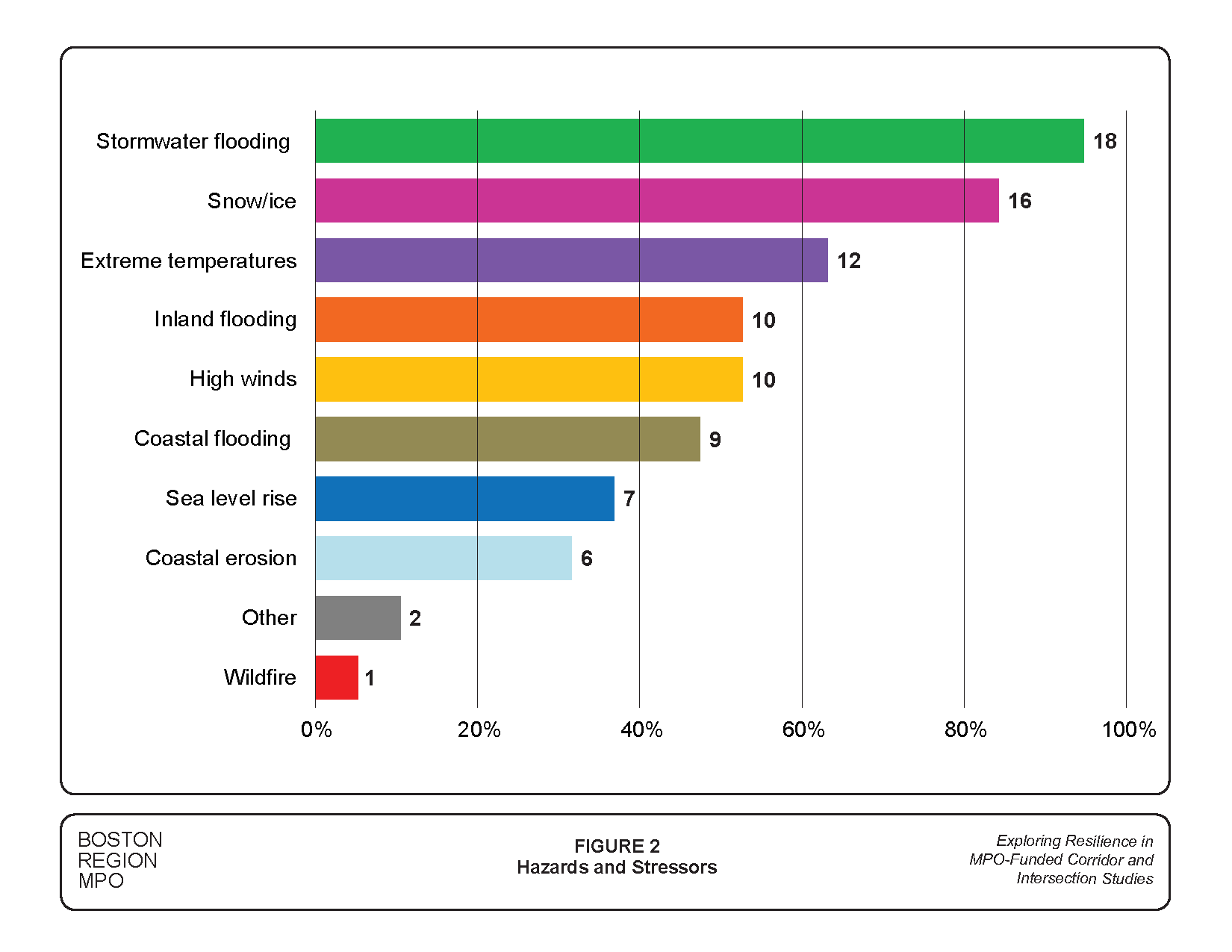
Figure 3
Transportation Assets Vulnerable to Climate Hazards
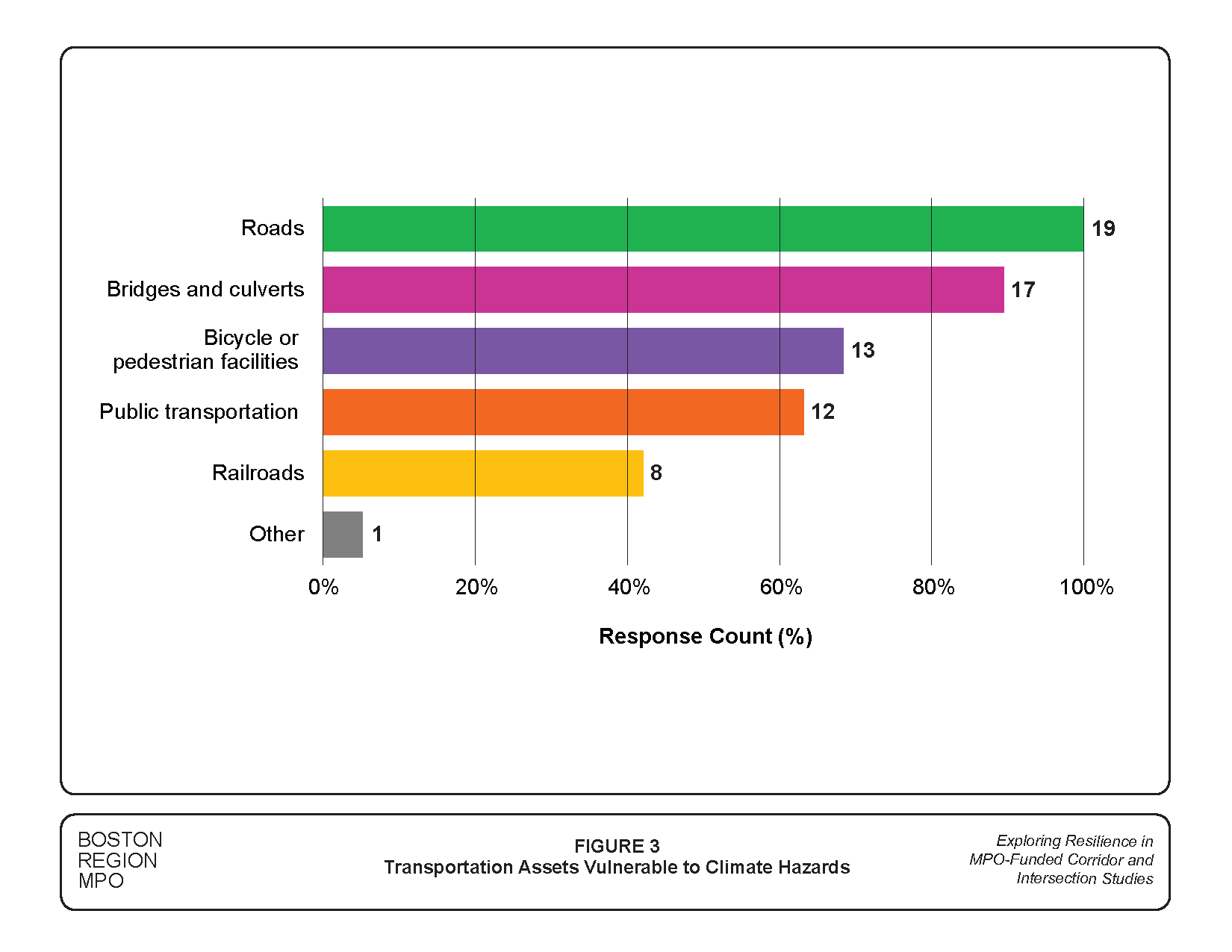
Figure 4
Transportation Resilience Tools
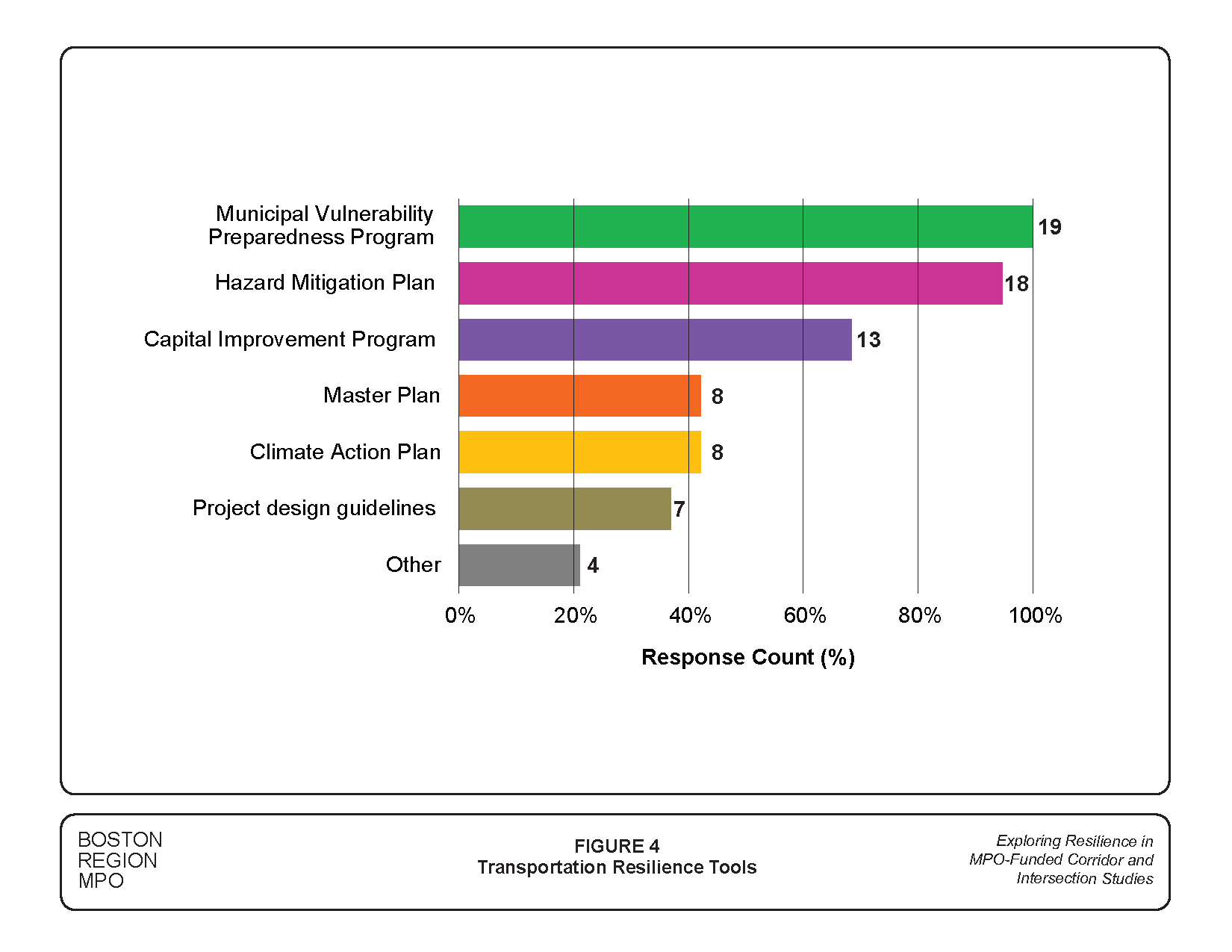
Figure 5
Climate Change Impacts of Greatest Concern to Transportation Assets
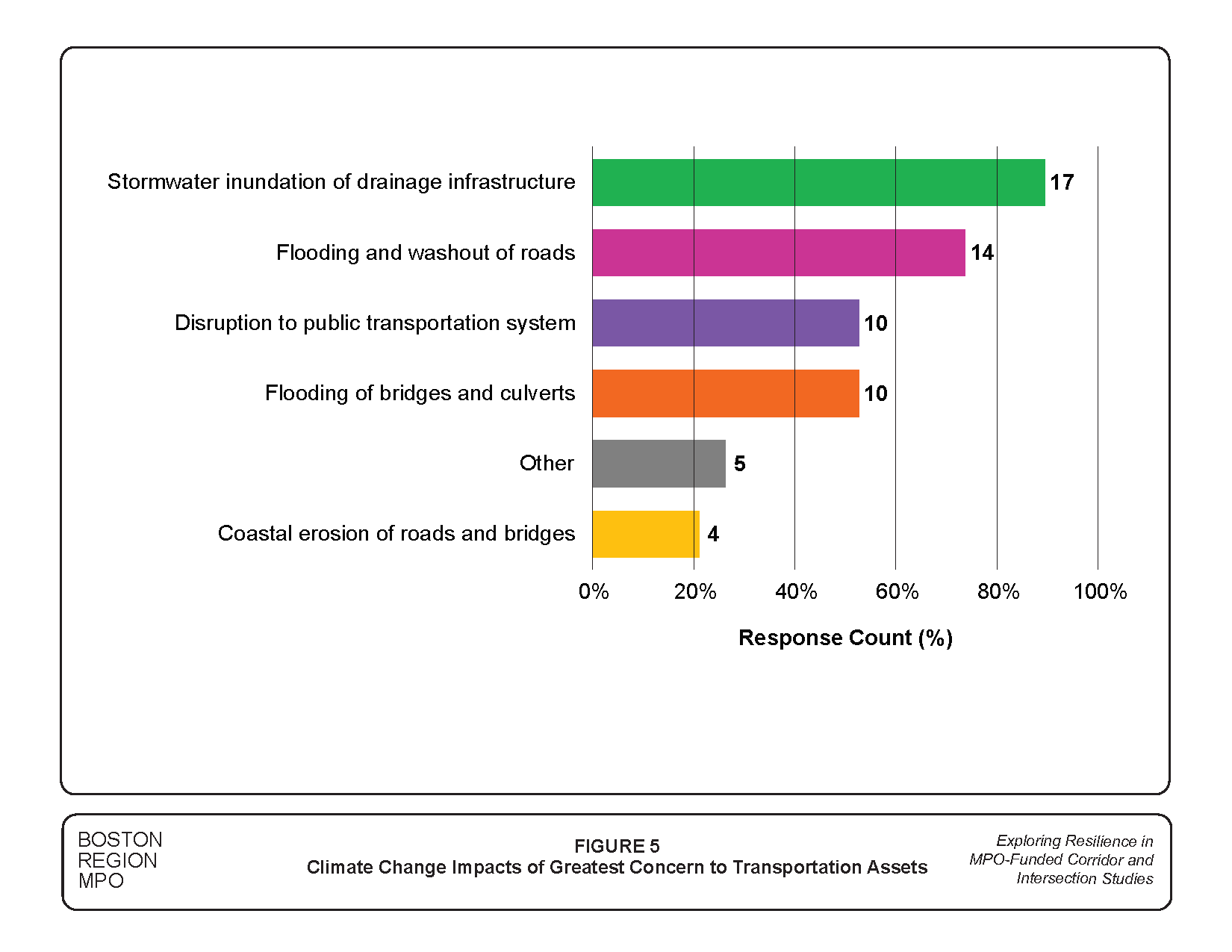
Figure 6
Top Recommendations to Improve Transportation Resilience
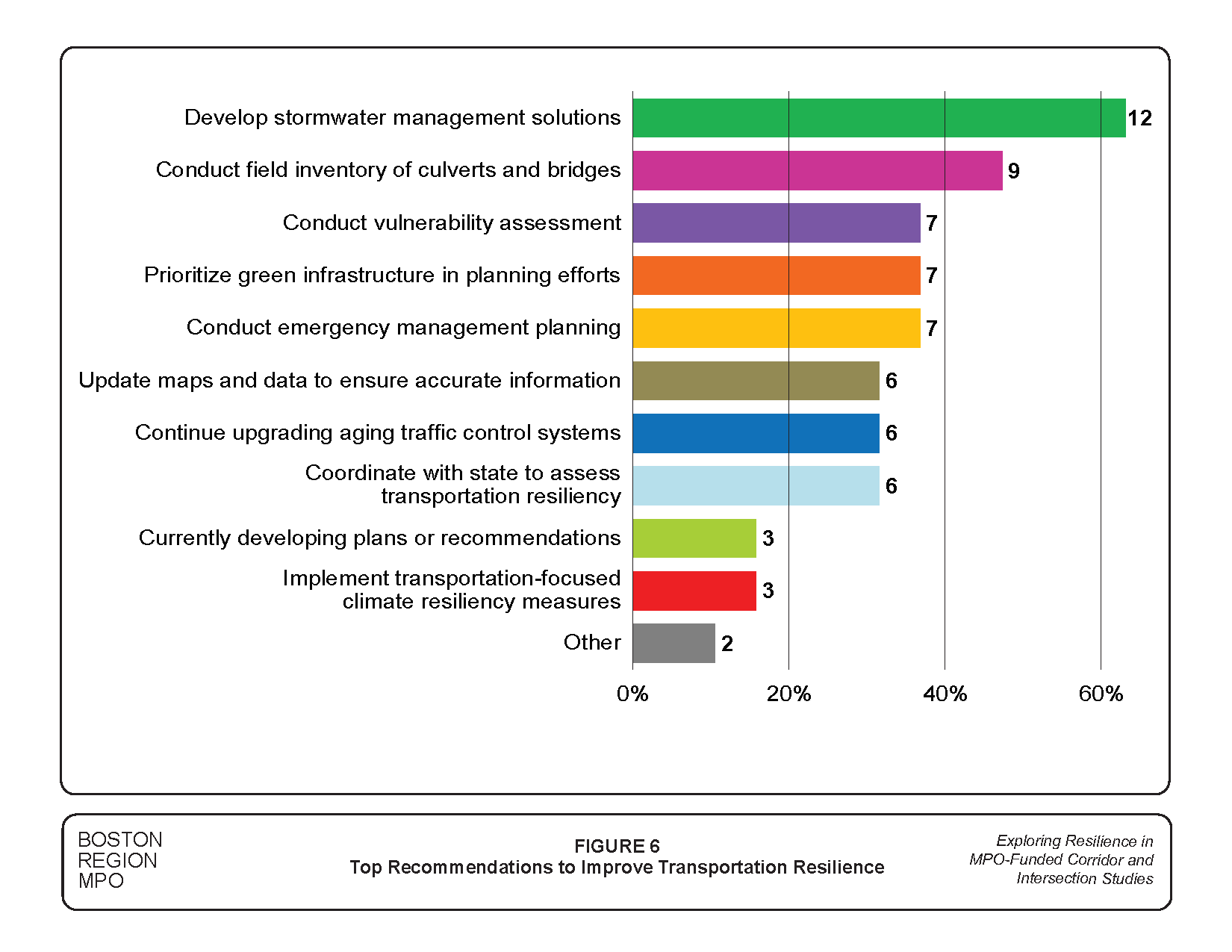
Figure 7
Policy Measures or Action Plans to Make Transportation System Resilient
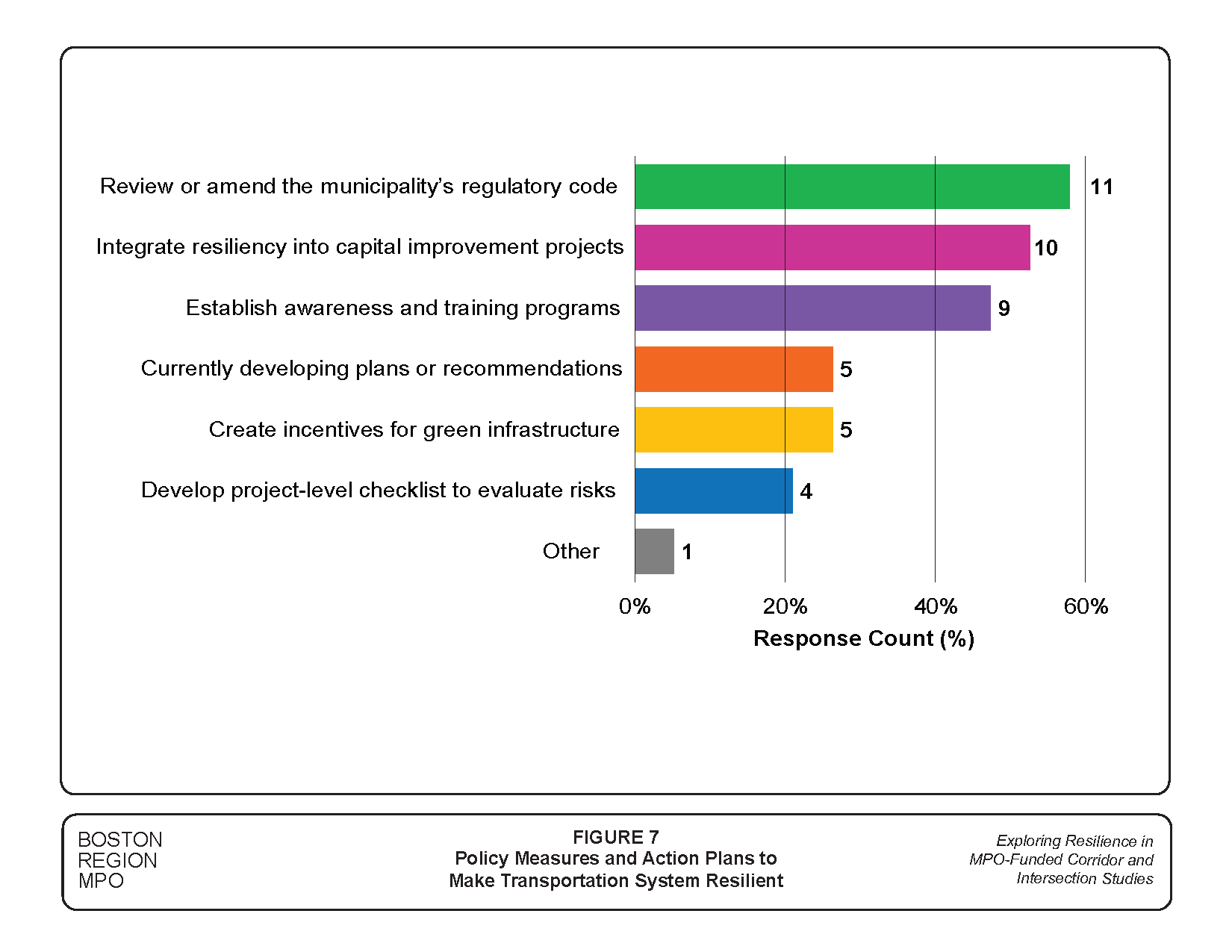
Figure 8
Actions to Improve Resilience of the Regional Transportation System

Figure 9
Types of Technical Assistance to Municipalities
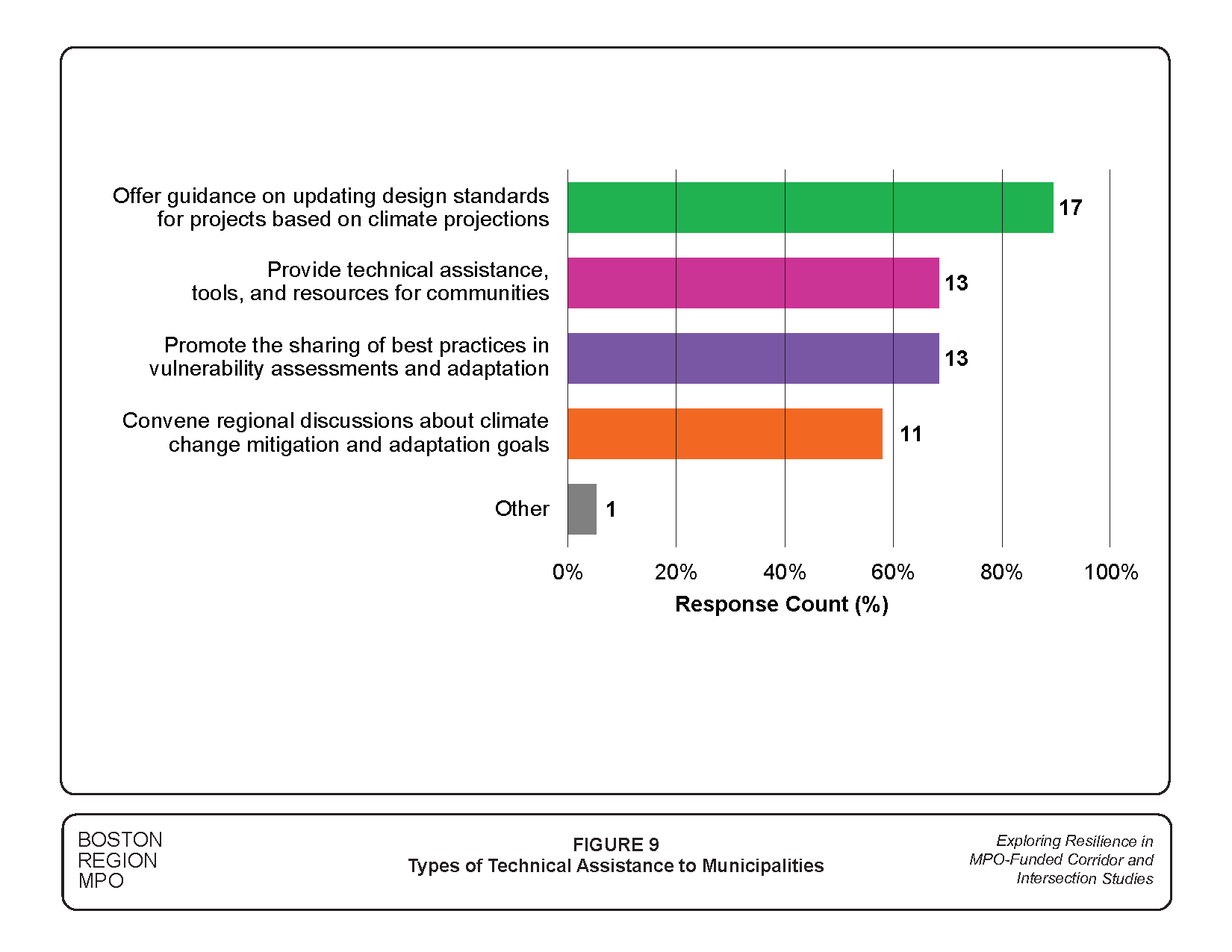
The Route 1A traverses natural low-lying areas with elevations around 10 feet above sea level (surveyed relative to the North American Vertical Datum of 1988 [NAVD 88]) and is close to the flood pathways of the Pines River estuary to the north and the Chelsea Creek estuary to the south. The corridor is highly vulnerable to flooding resulting from high tides, storm surge, and rain storms, and inundation from sea level rise, all hazards that are expected to worsen in the future. In the past, serious flooding and overtopping led to closures of the roadway for repair that lasted for two or more days. Route 1A passes through the Rumney Marsh Reservation, a coastal saltwater marsh and wetland, and home to a variety of wildlife. The marsh has been undergoing a restoration to preserve the natural resources and control flooding.
The purpose of the pilot study was twofold: (1) to work with MassDOT and the City of Revere to identify problems and develop recommendations to make Route 1A resilient and protect natural resources, and (2) to provide MPO staff with ideas of how to use available resources effectively to incorporate resilience into MPO-funded corridor and intersection studies and help municipalities seeking to address transportation resilience.
Route 1A in Revere was selected as the location for a pilot study after a review of other hazard-prone corridors in the Boston region. The selection process consisted of three steps:
The focus on coastal flooding narrowed the selection further to six corridors. Route 1A in Revere was selected because it is particularly vulnerable to flooding. The MassDOT Office of Transportation Planning is in the midst of the procurement process for a Route 1A East Boston Corridor Study. The local study area is anticipated to encompass the land segment west of Route 1A, as well as Route 1A from Chelsea Street/Saratoga Street to Bell Circle in Revere. The regional study area is expected to include East Boston, Revere, Lynn, Chelsea, and Winthrop. In addition, MassDOT Project 608396, Bridge Reconstruction, Route 1A over Saugus River, substructure and superstructure investigation and necessary repairs/reconstruction, is in the preliminary design stage. MassDOT is currently studying final structure options and coordinating with the United States Coast Guard and City entities at each end, in Revere and Lynn. MassDOT and the City of Revere have expressed support for the pilot study.
Route 1A is critical to the regional transportation system. It is an evacuation route and it provides access to residential, educational, recreational, commercial, and industrial areas. Residents of North Shore communities use this roadway to connect to Boston and Logan Airport and to access the Blue Line at the MBTA’s Wonderland Station in Revere. Classified as a principal arterial, Route 1A is part of the National Highway System (NHS) and it is federal-aid eligible. Traffic volumes vary along the corridor, from approximately 62,000 vehicles per day at the Boston and Revere city line to approximately 40,000 vehicles at the Lynn and Revere city line.
Figure 10 shows the study limits on the four-mile, four-lane highway between the Boston and Lynn city lines. This section of highway is open to all vehicles, has partial access control, and is a designated state truck route. The speed limits vary from 30 miles per hour (mph) at the busy segments to 50 mph in the less busy, unsettled areas. Figure 11 shows pictures of the roadway at several locations. MassDOT has jurisdiction of the road, which was recently transferred from the Department of Conservation and Recreation (DCR).
The assets on Route 1A were characterized to document their conditions and interdependencies. Table 1 presents the various assets in the corridor. Data on their locations and conditions were obtained from MassDOT’s geoDOT platform and the MPO’s data resources. Although, transportation assets are the focus of the study, the roadway coexists with natural resources and other facilities. Figure 12 shows the locations of the transportation assets: bridges, culverts, tidegates, and traffic signals.
Table 1
Route 1A Asset Category, Type, and Subtype
Asset Category |
Infrastructure |
Natural resources |
Asset Type |
Transportation |
Coastal resource area |
Asset Subtype |
Road |
Coastal wetland |
|
Bridge |
Land exposed to tidal action |
|
Culverts |
Saltwater marsh |
|
Tidegates |
Estuarine open water |
|
Bus stops |
|
Figure 10
Study Corridor
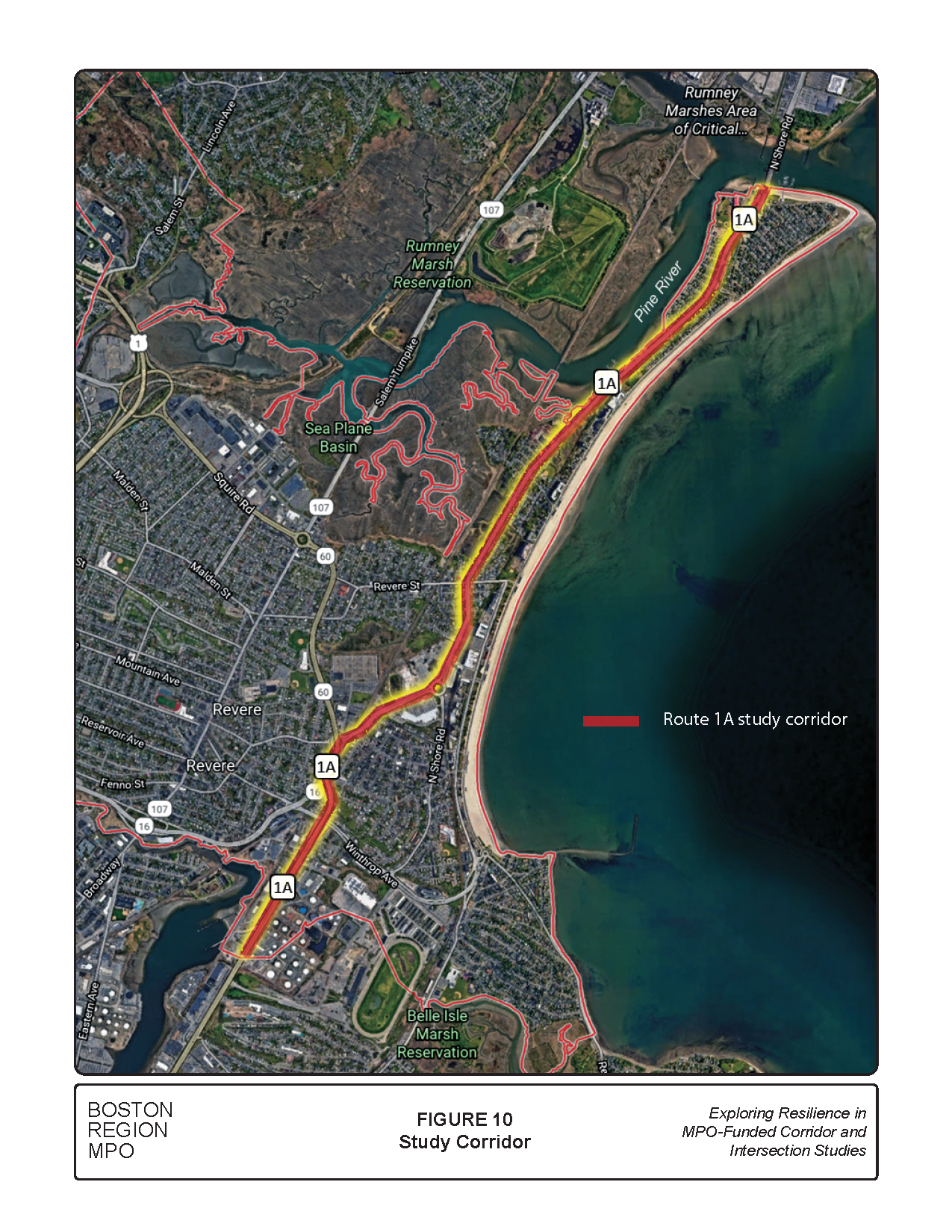
Figure 11
Existing Conditions
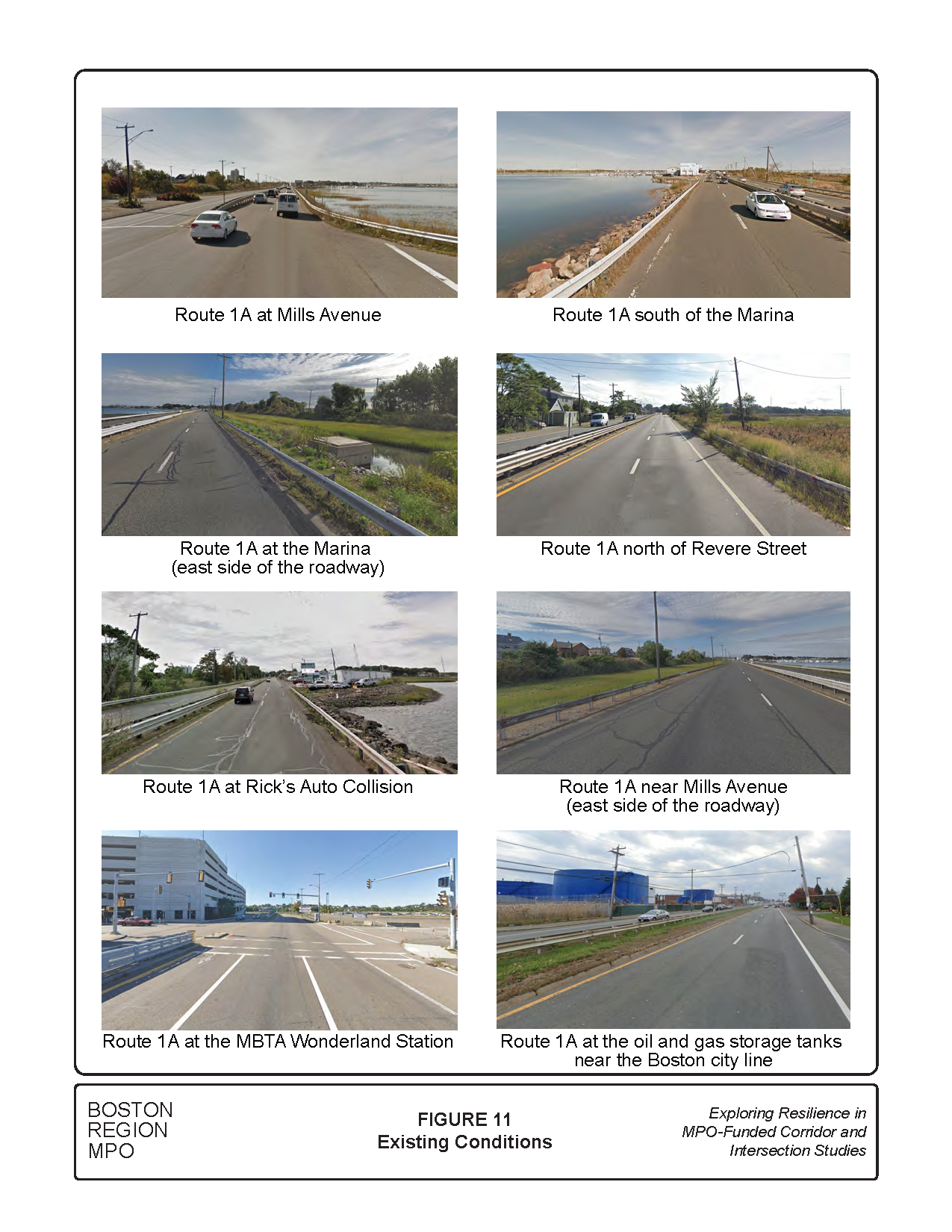
Figure 12
Transportation and Natural Resources Assets
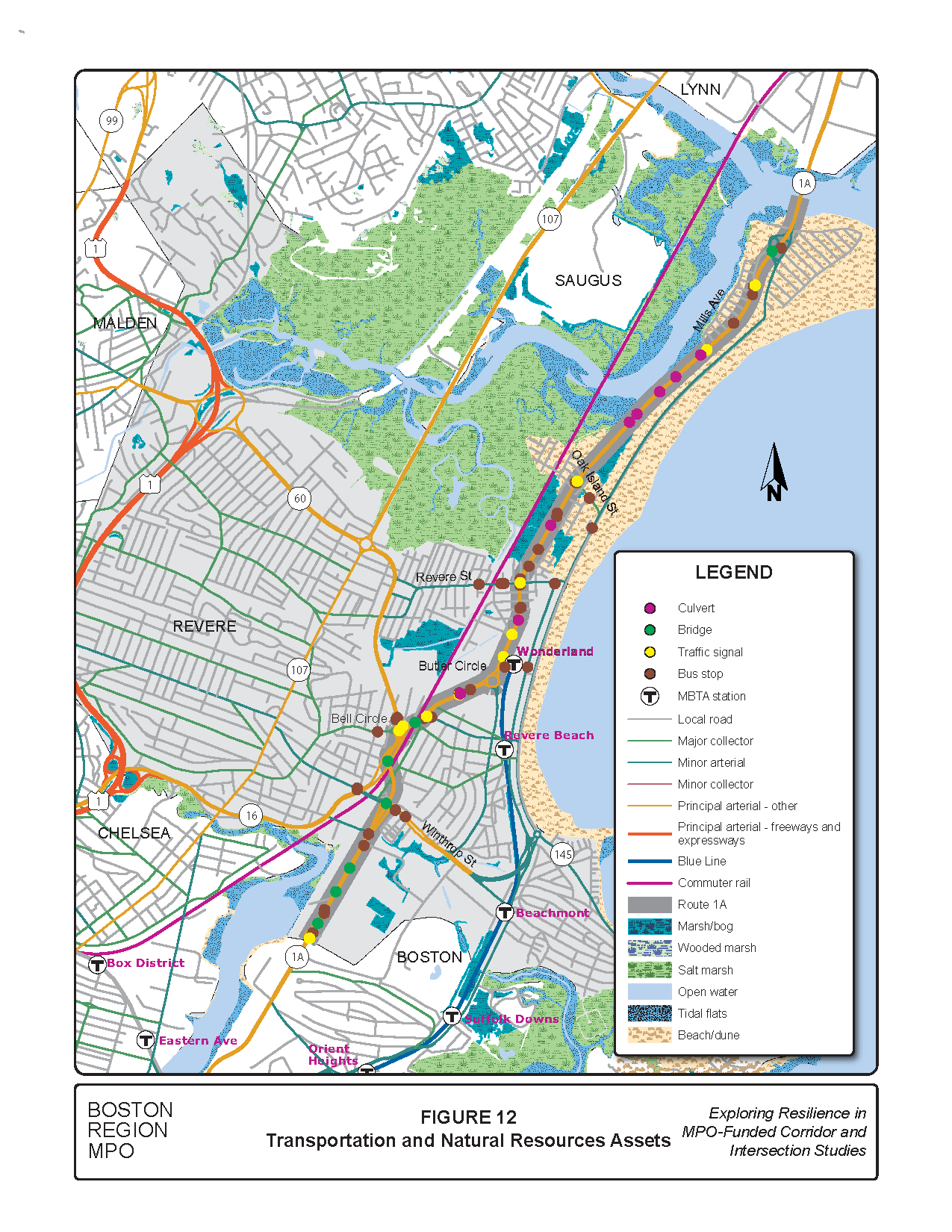
There are seven bridges within the study limits, all under MassDOT’s jurisdiction. Most of the bridges are located on the southern segment of the corridor, where they carry Route 1A over railroad, road, tunnels, and floodplains. The bridges were built between 1932 and 1934 and were reconditioned between 1975 and 1977. In the latest inspections in 2018, the superstructures, substructures, and decks received ratings between 5 and 7, which is fair condition.15 All of the bridges are open to traffic and none of them are structurally deficient.
There are nine culverts located in the study limits, most of them under Route 1A in the northern segment of the corridor. The culverts were installed in 1970 and last inspected in 2016. The seven culverts in the northern segment are connected by a ditch system that drains and feeds into the tidal saltwater marsh and brackish wetland area located between Revere Beach Reservation and Route 1A, north of Island Street. Another culvert under Route 1A is at the Eastern County ditch (located between Revere Street and Oak Island Street) and discharges to Diamond Creek. Existing culverts at the north of Revere have self-regulating tidegates, but some of them are not functioning well due to debris, missing top floats, crushed culvert outlets, or missing grated vault covers, or they are completely obstructed.
Presently, some of the most vulnerable locations on Route 1A are protected by rock revetments and drainage systems of ditches, culverts, and self-regulating tidegates. On site visits, MPO staff found that some of rock revetments require enhancements. Assessments by the US Environmental Protection Agency and the City of Revere’s engineering staff indicate that some culverts have failed because they are undersize or completely obstructed and the tidegates are not functioning well because of stuck or missing top floats.
There are seven self-regulating tidegates, all located in the northern segment of the corridor and integrated with the culvert-ditch drainage system. Drainage system inadequacies have been reported. These inadequacies result from overgrowth in ditches, debris obstructions in trash racks, and obstructions that leave flappers stuck in a half open position. The concern is that significant adverse impacts to the saltwater marshes would occur if malfunctioning tidegates restrict saltwater to the marshes.
There are 11 traffic signals in the corridor and all are operating well. All traffic signals are at intersections where vehicular or pedestrian traffic intersect with Route 1A. No information was available about the structural capacity of the signals and whether the poles and signal sections meet current MassDOT standards. In addition, there are signs and supports guiding motorists, bicyclists, and pedestrians through the corridor.
Three MBTA bus routes (Routes 439, 441, 442, and 450) operate on Route 1A, connecting to Wonderland Station in Revere, Central Square in Lynn, Logan Airport, and Boston. The bus routes have 21 bus stops on Route 1A in Revere. The MBTA’s Blue Line rapid transit service has its terminal at Wonderland Station; both the station and the parking lots are accessed from Route 1A. The Newburyport/Rockport commuter rail line passes under Route 1A at two locations near Bell Circle.
There are several critical facilities in the corridor, including police and fire stations, storm and wastewater pump stations, and schools. Figure 13 shows the locations and types of facilities. The pump station at Eastern County ditch headwall at the Boston and Maine (B&M) railroad tracks discharges to Diamond Creek. Flooding from storms can wreak havoc on these facilities and the gradual rise of sea levels also threatens to inundate critical facilities in the coming decades.
Rumney Marsh is a saltwater marsh and wetland that is home to a variety of wildlife. Figure 13 shows the location and extent of Rumney Marsh. Located in Revere and Saugus, it encompasses approximately 2,274 acres and has been identified by the Massachusetts Secretary of Energy and Environmental Affairs as an Area of Critical Environmental Concern due to its quality, uniqueness, and significance that need to be preserved. The United States Fish and Wildlife Service characterized Rumney Marsh as "one of the most biologically significant estuaries in Massachusetts north of Boston."
Figure 13
Critical Facilities
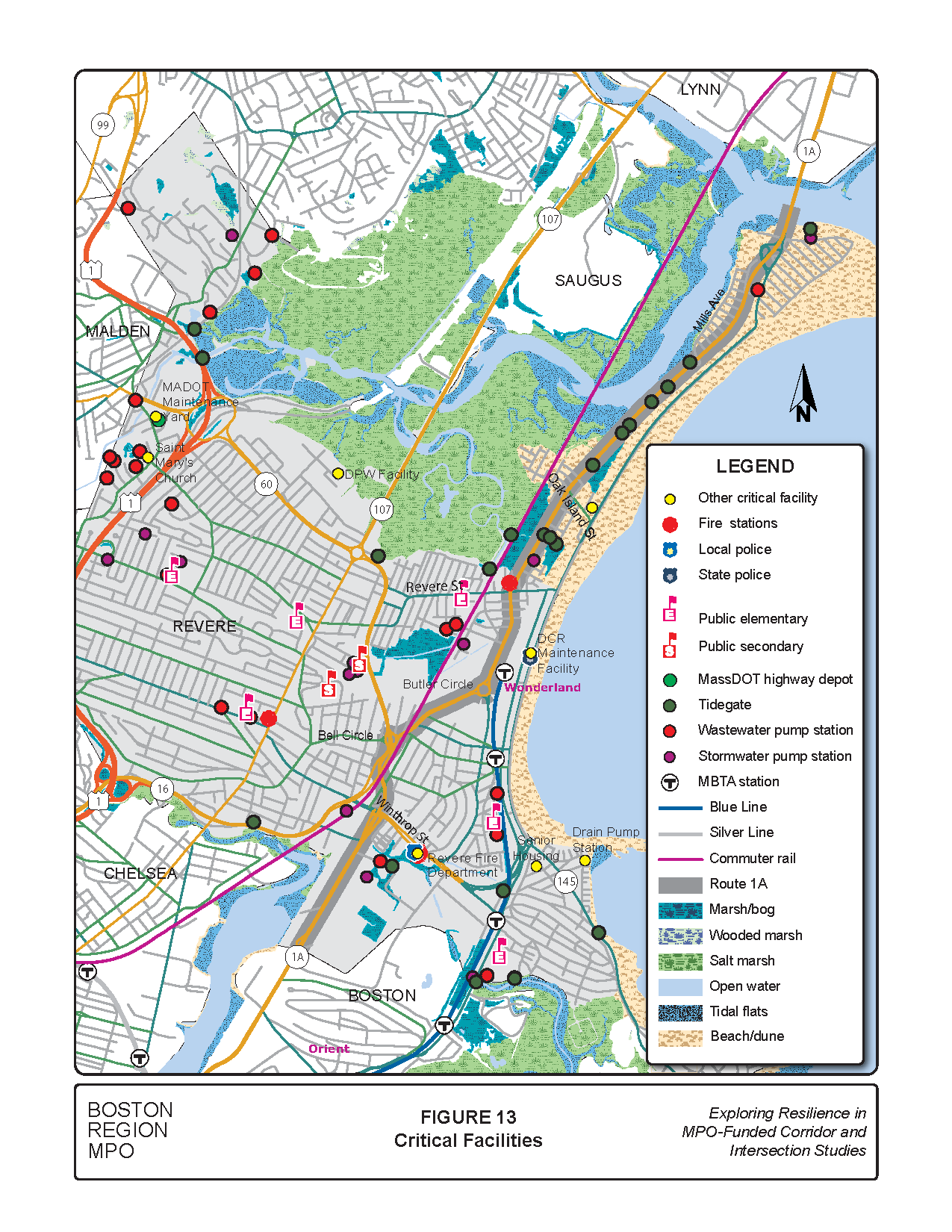
The initial assessment of Route 1A involved using readily available data and information to gain a general understanding about the challenges that flooding and sea level rise may present in the future. Tools from NOAA, FEMA, and CZM, such as sea level rise viewer, flood maps, and precipitation charts, were used to screen the corridor for vulnerabilities. The initial assessment also involved rating the asset’s exposure to climate hazards. Because the Route 1A corridor is vulnerable to several climate hazards, a focus of the study was to target areas that are most vulnerable and focus the development of adaptation measures to these areas.
With rising sea levels, flooding of natural low-lying areas along the Route 1A corridor is expected to occur due to more frequent tidal and storm surge inundation and stormwater flooding. Damage to infrastructure, natural resources, and facilities, including properties and neighborhoods, may occur as tidal and wave energy increases. Figure 14 shows probabilistic projections of how much and how quickly future mean sea level is likely to rise under two emission scenarios, RCP4.5 and RCP8.5.16 These RCPs represent the intermediate and worst-case scenarios, respectively.
By 2050, the sea level could rise between 1.3 to 4.0 feet, and between 2.3 to 5.5 feet by 2070 depending on how successful we are in reducing greenhouse gas emissions.
The CZM/NOAA sea level rise viewer was selected to review the impacts along the corridor of a three-foot sea level rise. The results show near- and medium-term flooding problems in the Route 1A corridor, especially for the segment of Route 1A north of Revere Street, which is in a low-lying area, on the flood pathways of the Pines River, and directly exposed to storm surges.
Figure 14
Relative Annual Mean Sea Level and Future Scenarios
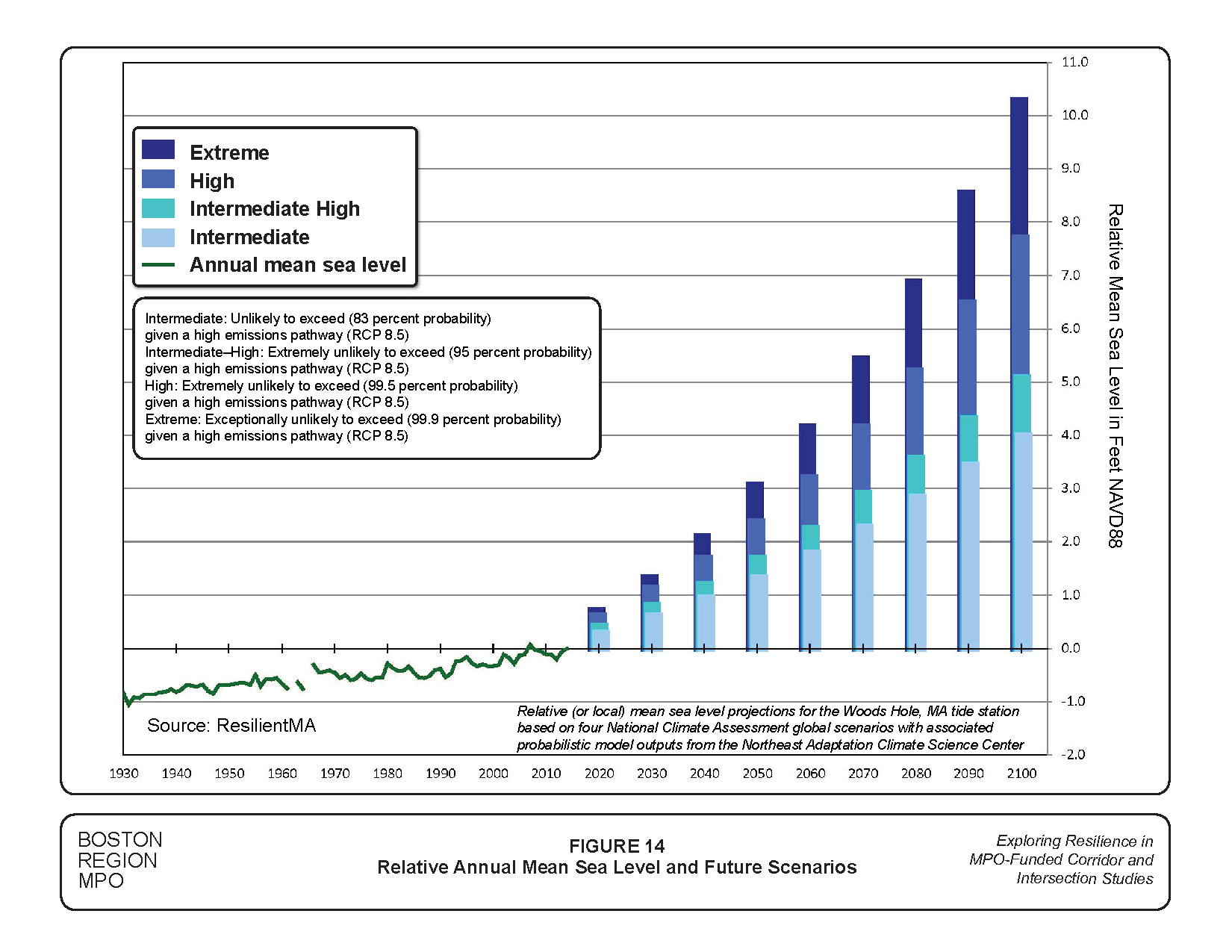
Estimated using tide gauge reading at Woods Hole, MA.
Intermediate: Unlikely to exceed (83 percent probability) given a high emissions pathway (RCP 8.5)
Intermediate–High: Extremely unlikely to exceed (95 percent probability) given a high emissions pathway (RCP 8.5)
High: Extremely unlikely to exceed (99.5 percent probability) given a high emissions pathway (RCP 8.5)
Extreme: Exceptionally unlikely to exceed (99.9 percent probability) given a high emissions pathway (RCP 8.5)
Source: ResilientMA
Climate change is projected to produce more intense rain storms. Extreme precipitation may result in stormwater flooding, which could disrupt traffic, overtop or wash out roadways, damage undersized culverts, and overtop bridges. Table 2 shows estimated 50th percentile values for projected change in precipitation greater than two inches, precipitation greater than four inches, and total precipitation for two emission scenarios, RCP4.5 and RCP8.5.
Projections indicate that total annual precipitation would increase by three inches by 2050 and four inches by 2070. Also, the number of days with more than two inches of precipitation would increase in the future.
Table 2
Annual Projected Change in Precipitation
Precipitation Parameter |
Baseline |
Emission Scenario |
2030s |
2050s |
2070s |
2090s |
Precipitation more than 2 inches |
1.10 days |
High RCP8.5 |
+0.27 |
+0.34 |
+0.48 |
+0.59 |
Precipitation more than 2 inches |
1.10 days |
Medium RCP4.5 |
+0.18 |
+0.30 |
+0.30 |
+0.23 |
Precipitation more than 4 inches |
0.07 days |
High RCP8.5 |
+0.06 |
+0.05 |
+0.05 |
+0.07 |
Precipitation more than 4 inches |
0.07 days |
Medium RCP4.5 |
+0.06 |
+0.07 |
+0.05 |
+0.05 |
Total precipitation |
45.31 inches |
High RCP8.5 |
+2.46 |
+2.97 |
+3.82 |
+4.01 |
Total precipitation |
45.31 inches |
Medium RCP4.5 |
+1.54 |
+3.16 |
+2.58 |
+4.11 |
Source: ResilientMA.
Figure 15 shows the parts of Route 1A that are vulnerable to flooding in a 100-year and 500-year storm. There is a one percent chance annually of a 100-year storm and a 0.2 percent chance of a 500-year.
Higher temperatures can cause pavement to soften and expand. This can create rutting and potholes, particularly in high-traffic areas, and stress bridge joints. Generally, extreme heat is more than 90 degrees Fahrenheit and a heat wave is three or more consecutive days of these temperatures. Table 3 shows the likely annual average change in temperature for two emissions scenarios used in this study.
By 2050, days with temperatures greater than 90 degrees could increase by 13 to 20 days and by 16 to 35 days by 2070. Also, annual maximum temperature could increase by three to five degrees by 2050 and four to seven degrees by 2070.
Figure15
FEMA National Flood Hazard Layer for Revere
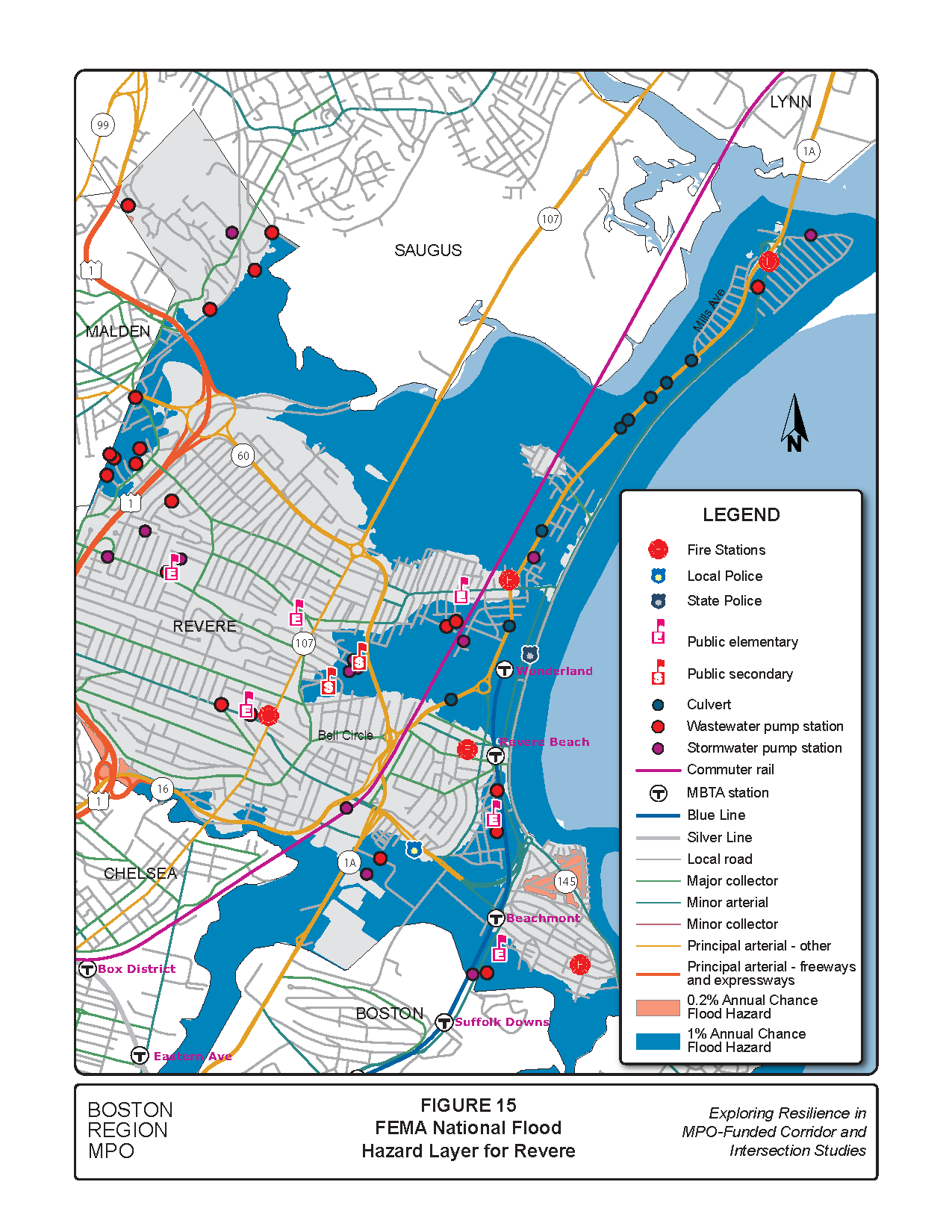
Table 3
Projected Annual Average Change in Temperature
Temperature Parameter |
Baseline (Days) |
Emission Scenario |
2030s |
2050s |
2070s |
2090s |
Days hotter than 90o F |
7.69 |
High RCP8.5 |
+10.74 |
+20.53 |
+35.22 |
+48.54 |
Days hotter than 90o F |
7.69 |
Medium RCP4.5 |
+8.51 |
+13.82 |
+15.50 |
+17.84 |
Days hotter than 95o F |
0.88 |
High RCP8.5 |
+3.22 |
+7.01 |
+15.53 |
+25.32 |
Days hotter than 95o F |
0.88 |
Medium RCP4.5 |
+2.24 |
+4.10 |
+4.73 |
+5.95 |
Maximum temperatures |
59.15 |
High RCP8.5 |
+3.38 |
+5.15 |
+7.16 |
+9.12 |
Maximum temperatures |
59.15 |
Medium RCP4.5 |
+2.60 |
+3.76 |
+4.31 |
+4.76 |
Source: ResilientMA.
Exposure and criticality analyses provide an understanding of an asset's potential vulnerability and the consequences of losing that asset for informed decision-making. Three types of assessments are conducted in these analyses:
The entire Route 1A corridor is exposed to climate hazards. Spreadsheets developed by RMAT were used in screening, scoring, and rating Route 1A’s exposure to climate hazards. Table 4 presents the exposure rating, which indicates that Route 1A is highly exposed sea level rise, storm surge, extreme precipitation, and extreme heat. Appendix E includes the RMAT worksheets used for the exposure screening.
Table 4
Preliminary Exposure Rating
Climate Parameter |
Exposure Rating |
Sea level rise /storm surge |
High exposure |
Extreme precipitation—riverine |
High exposure |
Extreme precipitation—urban |
High exposure |
Extreme heat |
High exposure |
Source: Central Transportation Planning Staff.
The criticality rating for Route 1A and its surrounding natural resources was based on questions about scope, time, and severity developed by the RMAT for screening infrastructure and natural resources assets. The scope of this study did not allow for an assessment of individual transportation assets, such as bridges, culverts, tidegates, and bus stops. In addition, the natural resources in the corridor, including saltwater marshes, land subject to tidal action, estuarine open water, and coastal wetlands, were not assessed individually. Detailed criticality studies of the specific assets are appropriate in functional design reports and conditional assessment reports.
Table 5 presents the criticality ratings for the transportation infrastucture and natural resources along Route 1A. Based on the screening and scoring, Route 1A and surrounding natural resources assets were rated as medium. The criticality worksheets with the scores are included in Appendix E.
Table 5
Preliminary Criticality
Asset |
Criticality |
Route 1A |
Medium |
Natural resources |
Medium |
Source: Central Transportation Planning Staff.
Table 6 is a risk matrix. It combines the exposure and criticality ratings in Table 4 and Table 5 into a risk rating. For example a high exposure rating and a medium criticality rating results in a high risk rating. Table 7 presents the asset risk rating for Route 1A. Based on the matrix, Route 1A assets (Section 5.5.1) are rated high risk—highly vulnerable to sea level rise and storm surge, extreme precipitation, and extreme heat.
Table 6
Matrix of Risk Rating
Criticality |
Not Exposed |
Low Exposure |
Moderate Exposure |
High Exposure |
High |
Low Risk |
Moderate Risk |
High Risk |
High Risk |
Medium |
Low Risk |
Low Risk |
Moderate Risk |
High Risk |
Low |
Low Risk |
Low Risk |
Moderate Risk |
Moderate Risk |
Source: ResilientMA.
Table 7
Asset Risk Rating for Route 1A
Climate Parameter |
Exposure Rating |
Risk Rating Infrastructure |
Risk Rating Natural Resources |
Sea Level Rise/Storm Surge |
High |
High |
High |
Extreme Precipitation (Riverine) |
High |
High |
High |
Extreme Precipitation (Urban) |
High |
High |
High |
Extreme Heat |
High |
High |
High |
Source: Central Transportation Planning Staff.
Evaluation of vulnerabilities and resilience of the Route 1A involved evaluating flood probabilities and depth of flooding for four scenarios—present-day, 2030, 2050, and 2070. These criteria were assessed using MC-FRM’s probability-based maps.
Figures 16 through 19 show the flood risk probability maps for present day, 2030, 2050, and 2070 planning horizons. Figures 20 through 23 show the one percent flood depth maps for the same planning scenarios. Risk mapping shows areas vulnerable to flooding from different combinations of sea level rise, storm surge, tides, and waves and provide flood information that can be used to inform adaptation plans to better protect assets. Risk mapping also strengthens the ability to make informed decisions about reducing risk. The maps show significant flooding in the near- and medium-term that require actions to protect assets.
Based on the risk maps, the Route 1A corridor was divided into two segments (northern and southern) based on similarities and consistencies in physical conditions such as geography, dominant land use, and road elevations. The purpose of the division was to prioritize improvements and allow resources to be focused on the most vulnerable segment. Also, improvements suggested for each segment are influenced by the characteristics in the segment.
The northern segment extends from Revere Street to the Point of Pines. In this segment, approximately two miles long, Route 1A is in a natural low-lying area about eight to nine feet above sea level (NAVD 88). The roadway is close to the banks and flood pathways of the Pines River estuary and is highly vulnerable to flooding resulting from high tides, storm surge, and rain storms, and inundation from sea level rise. In the past, serious flooding and overtopping of the roadway led to closure of the road for repair that lasted for two or more days. Rock revetments have been installed where the roadway is directly adjacent to the riverbank. The northern segment also passes through the Rumney Marsh Reservation, a coastal saltwater marsh and wetland and home to a variety of wildlife. The land use is mixed, primarily residential with some commercial areas in the vicinity of Oak Island Street.
Figure 16
Present Day Flood Probabilities

Figure 17
2030 Flood Probabilities
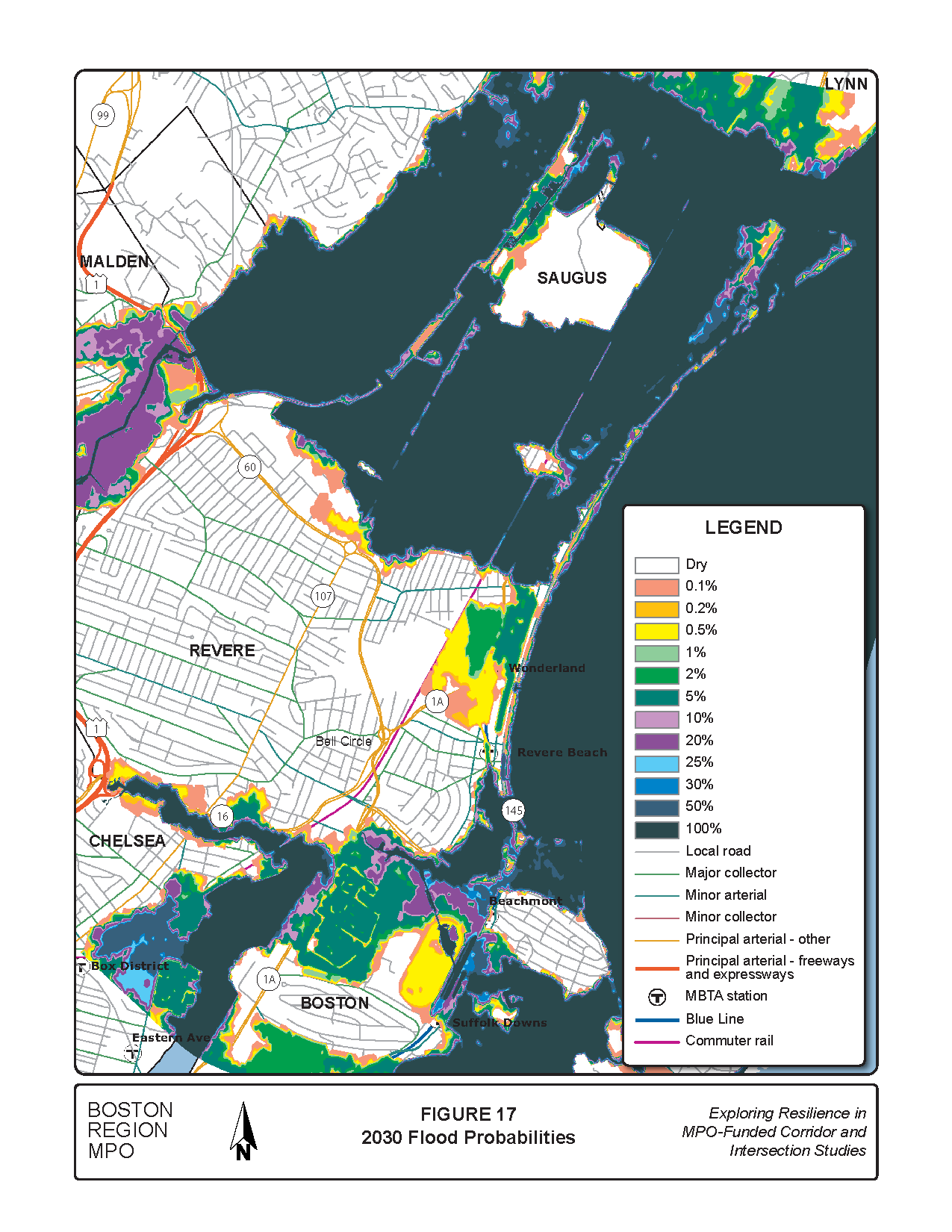
Figure 18
2050 Flood Probabilities

Figure 19
2070 Flood Probabilities
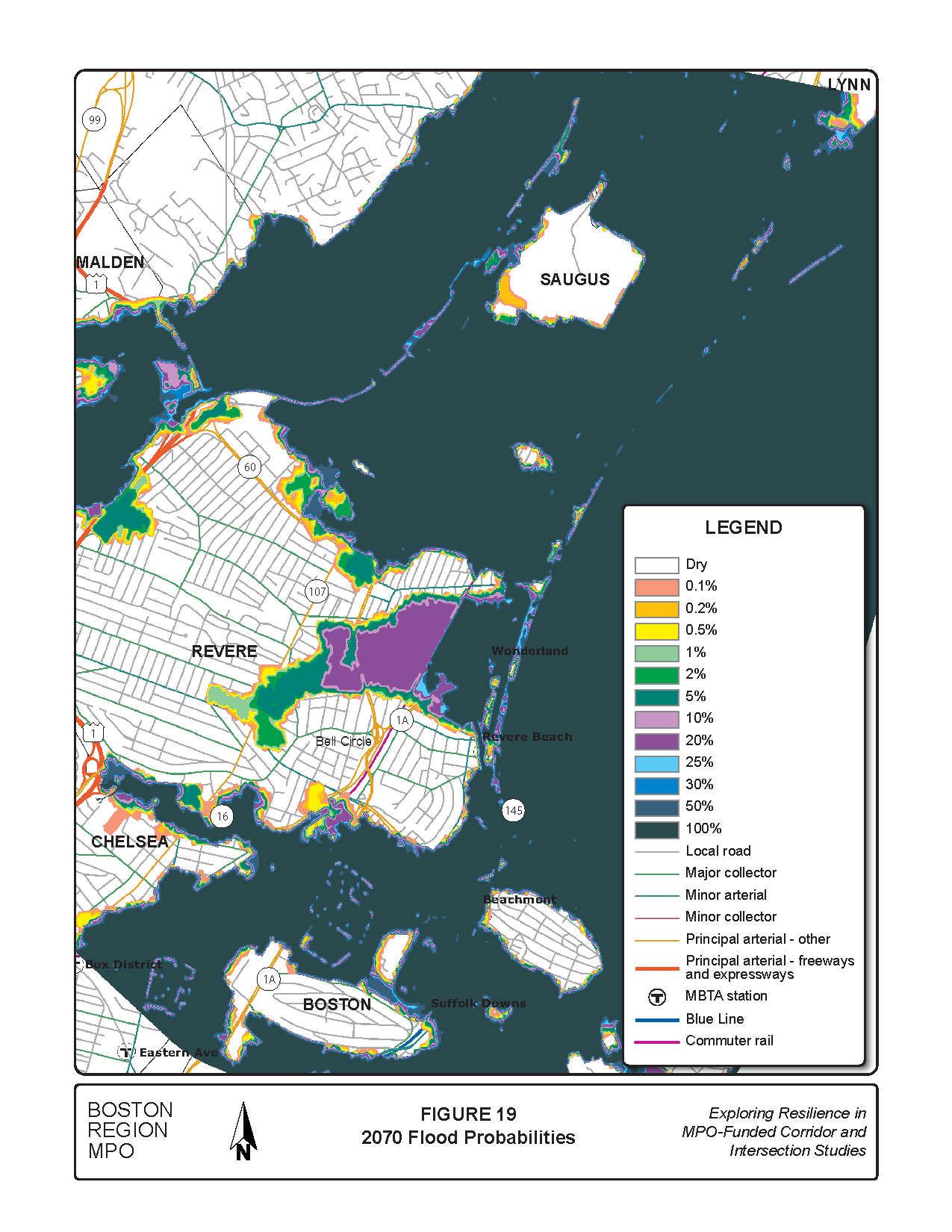
Figure 20
Present Day Depth of Flooding
(1% Annual Exceedance Probability)

Figure 21
2030 Depth of Flooding
(1% Annual Exceedance Probability)
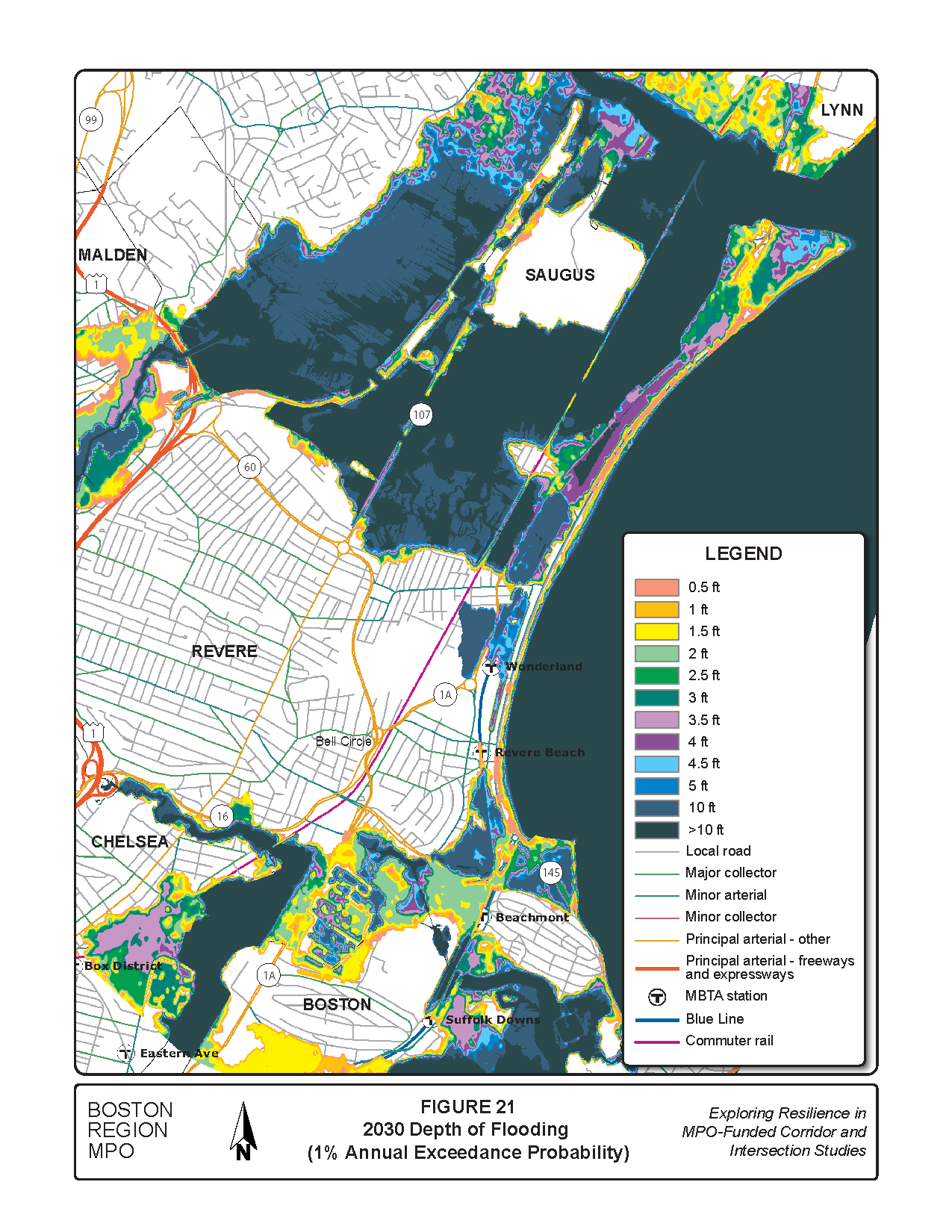
Figure 22
2050 Depth of Flooding
(1% Annual Exceedance Probability)
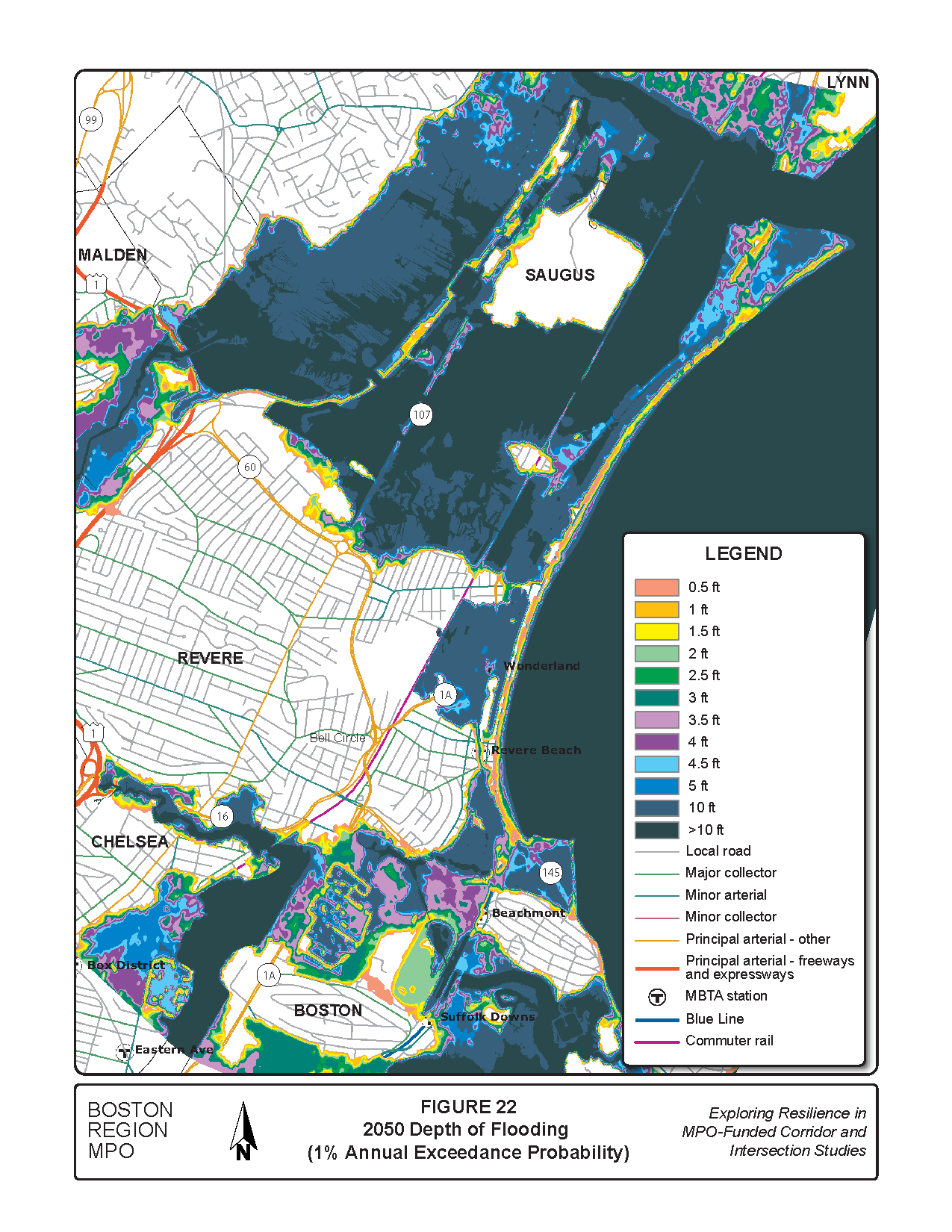
Figure 23
2070 Depth of Flooding
(1% Annual Exceedance Probability)
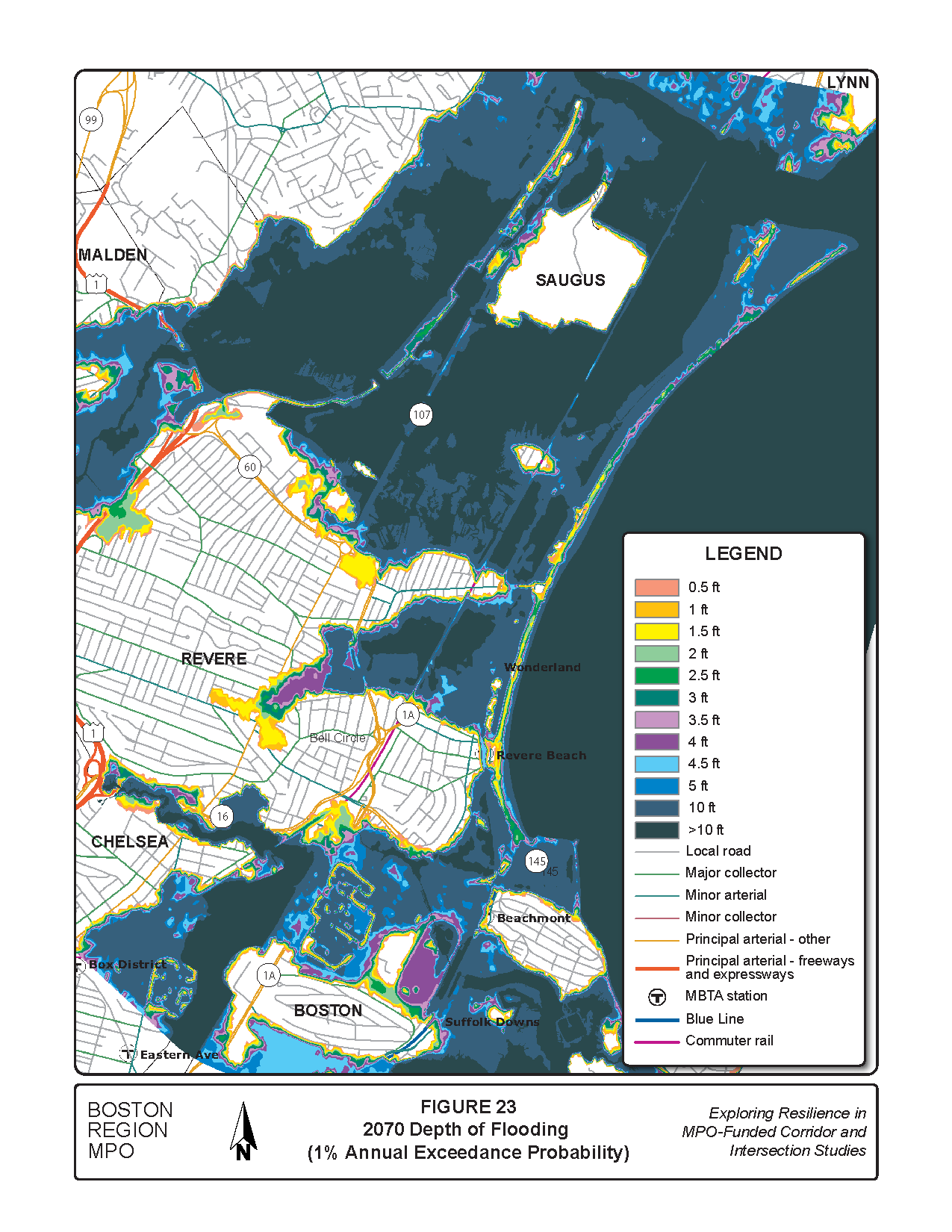
The northern segment of Route 1A is the critical segment where resilience efforts should be focused now. The northern segment experiences the most significant flooding currently, and flooding would worsen in 2030 and in subsequent planning horizons. Many of the Route 1A assets in the segment—road, bridges, culverts, tidegates, supports (for signs, signals, gantries), electrical, and bus stops are at risk from flooding.
The consequences of losing Route 1A are immense for Revere and many North Shore communities. Route 1A serves regional traffic, passes through communities with transportation equity zones, and serves as an evacuation route. Its loss would be felt immediately after an event as many of the parallel routes (Route 107) and other transportation choices (MBTA commuter rail or rapid transit) face the same flooding issues as Route 1A. Diversion routes would increase trip length, duration, and result in congestion. Economic and social impacts would be high for businesses and transportation equity zones that it serves. As the risk worsens in 2030 and 2050, keeping Route 1A functional would require costly maintenance and repair, unless resilience measures are taken earlier to prevent that from happening.
The southern segment of Route 1A extends approximately two miles from the Boston city line to Revere Street. Although this segment is not as vulnerable as the northern segment, there are two natural low-lying areas about eight to ten feet above sea level (NAVD 88):
The dominant land uses in the segment are industrial and commercial, mostly located in the low-lying areas, and residential in the elevated area between the two low-lying areas.
The southern segment experience far less flooding presently compared to its northern counterpart.
Although the southern segment is not as critical as the northern segment, by 2050 some resilience efforts would be needed in the segment, especially the in the low-lying areas. The consequences are the same as in the northern segment.
The cost of replacing or repairing the roadway after a failure would likely be millions of dollars and the economic (and social) impact to the area would be significant. Environmental impacts on natural resources are difficult to assess at this stage. The options for making Route 1A resilient include near-term, medium-term, and long-term improvements of infrastructure and protection of natural resources:
The Do-Nothing option is assessed from a planning perspective, focusing on broad consequences as a result of inaction, to bring the issues to attention and to begin stakeholder discussions. Detailed evaluation in terms of economic cost, social, and ecological impacts, are beyond the scope this study.
Loss of Route 1A would adversely impact transportation for Revere and North Shore communities, as the parallel roads, such as Route 107, and the MBTA Newburyport/Rockport commuter rail also have similar flooding issues. Hence, diversion routes would add tens of miles and cause significant delay to users.
The Do-Nothing option is not appropriate for the northern segment of Route 1A. However, it might be worth considering for the southern segment, where significant inundation is not expected to occur until 2050.
If the Do-Nothing option is selected, the northern segment would be subjected to frequent inundations beginning in 2030 with frequent overtopping and the roadway would be expensive to maintain. This option would present several problems.
A Do-Nothing option would not benefit current and future investments on Route 1A in the neighboring communities. There are several projects on Route 1A that would not benefit from this option. The General Edwards Drawbridge is one example. The General Edwards Drawbridge is located on Route 1A over the Saugus River in Lynn and Revere. In 2014, MassDOT project #605515 repaired and replaced electrical and mechanical operating machinery of the drawbridge, rehabilitated and made architectural repairs to the operator’s rooms and tower, miscellaneous granite repairs, and various structural steel repairs. The project was completed in 2014 at an estimated cost of $10.3 million.
In 2016, MassDOT Project #608396 was initiated and approved for the reconstruction of General Edwards Drawbridge. The project consists of substructure and superstructure investigation and necessary repairs and reconstruction, which are estimated to cost about $75 million. Currently the project is in preliminary design phase.
The Do-Nothing option would be expected to result in significant economic loss to the state and adverse social impacts on vulnerable populations.
Although there are no project costs associated with the Do-Nothing option, the economic, social, and transportation costs are very high.
Nature-based solutions to coastal highway resilience is growing in popularity because they are effective low-cost alternatives that blend in with the natural environment. They are created by human design, engineered, and constructed to mimic nature. Examples include the restoration of saltwater marshes to minimize the impacts of flooding and edging, coir rolls, berms, and sills to prevent erosion.17 Restoring marsh areas that have been invaded by Phragmites would help prevent and control flooding by increasing flood storage volume and absorbing some wave energy. 18 Nature-based solutions require experts to identify local marsh species, geological conditions, and drainage systems.
The City of Revere is already leading efforts to restore the Oak Island Saltwater Marsh, located between the MBTA Newburyport/ Rockport commuter rail line and Route 1A and part of the Rumney Marsh Reservation. The City has already restored 6.6 acres of saltwater marsh in the study area and is working on restoring an additional 7.3 acres.
Phase 2 and 3 of the City’s marsh restoration and flood storage efforts will continue on both sides Route 1A between Revere Street and Oak Island Street. The marsh restoration was accomplished through removal of fill and sediment, excavation to create a system of feeder creeks, and reestablishment of saltwater marsh grasses.
Poor tidal exchange of saltwater to the surrounding marshes has resulted in the growth of invasive Phragmites that have outgrown some saltwater marsh areas, reducing flood water storage, increasing sedimentation, and exacerbating flooding. Figure 24 shows the locations of the saltwater marshes and invasive Phragmites where tidal flows have been restricted in the Rumney Marsh Reservation. Figure 25 shows nature-based solutions for flood and erosion control.
Figure 24
Rumney Marsh Restoration Areas
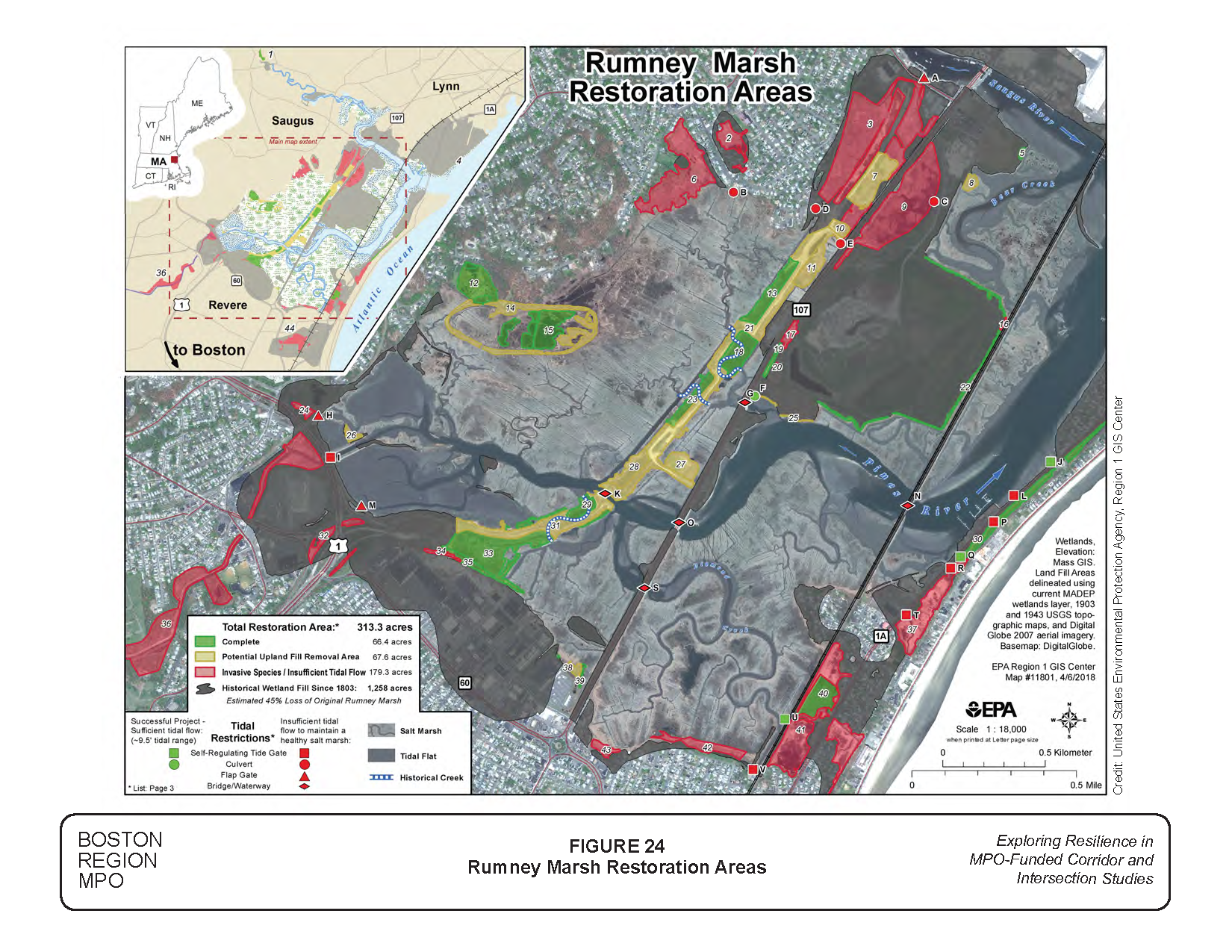
Figure 25
Nature-Based Flood and Erosion Control
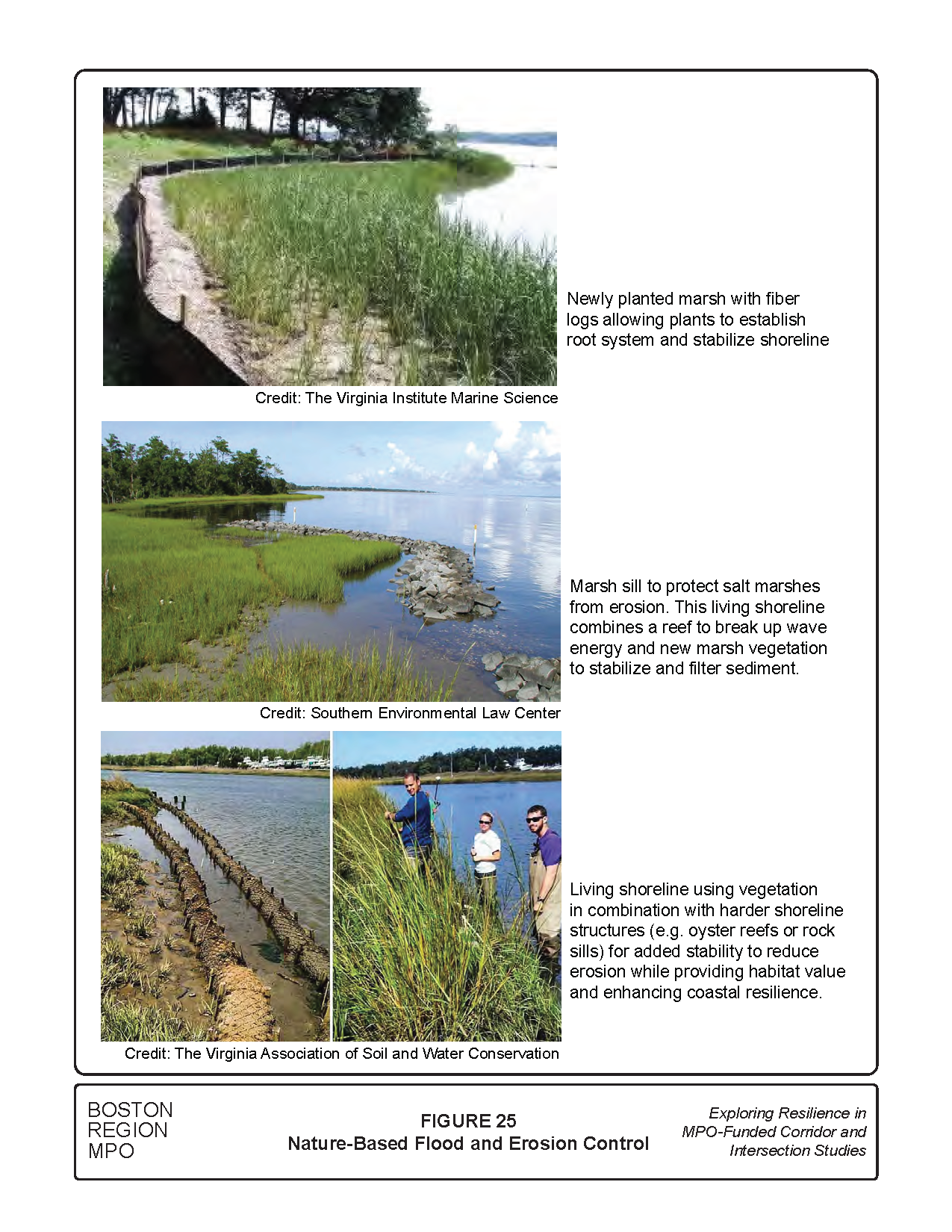
Nature-based solutions are recommended for the northern segment of Route 1A because it complements restoration efforts of the Rumney Marsh Reservation. When maintained regularly, nature-based solutions can provide medium- to long-term improvement options. On the other hand, nature-based solutions may not be appropriate for the southern segment of Route 1A, as the area is fully built and occupied.
This option aligns with current restoration efforts for the Rumney Marsh Reservation.
The costs of nature‐based solutions depend on the magnitude of exposure to wave energy. Costs can range from $100 to $200 per linear foot for shorelines exposed to low wave energy, $200 to $500 per linear foot for shorelines exposed to medium energy, and $600 to $1,200 per linear foot for shorelines exposed high energy waves that may require structural measures such as revetments, breakwaters, and bulkheads.
This strategy is the focus of the Regional Saugus River Floodgate Project, which consists of a floodgate on the mouth of Saugus River with nine gated openings that is tied to 3.1 miles of shorefront improvements along the Lynn Harbor, Point of Pines, and Revere Beach Reservation. The project has received renewed interest and taken on a regional approach to address climate change and rising sea level by providing high level coastal protection for five communities: Everett, Lynn, Malden, Revere, and Saugus. Figure 26 shows the components of project.
The floodgate strategy is expected to protect assets in the region vulnerable to flooding and storm surges—5,000 buildings, 8,000 housing units, 10,000 residents, 20,000 employees, and 40,000 commuters. The project also includes restoration of the Rumney Marsh Reservation, including enhancement and reestablishment of natural tide levels and flushing to 500 acres of the upper estuary and wetlands. This project was initially requested by federal and state agencies and the Town of Saugus. For more information about this project visit www.saugusriverfloodgate.com.
The floodgate strategy has a regional project focus that would offer flood protection for five municipalities.
Figure 26
Saugus River Floodgate Project
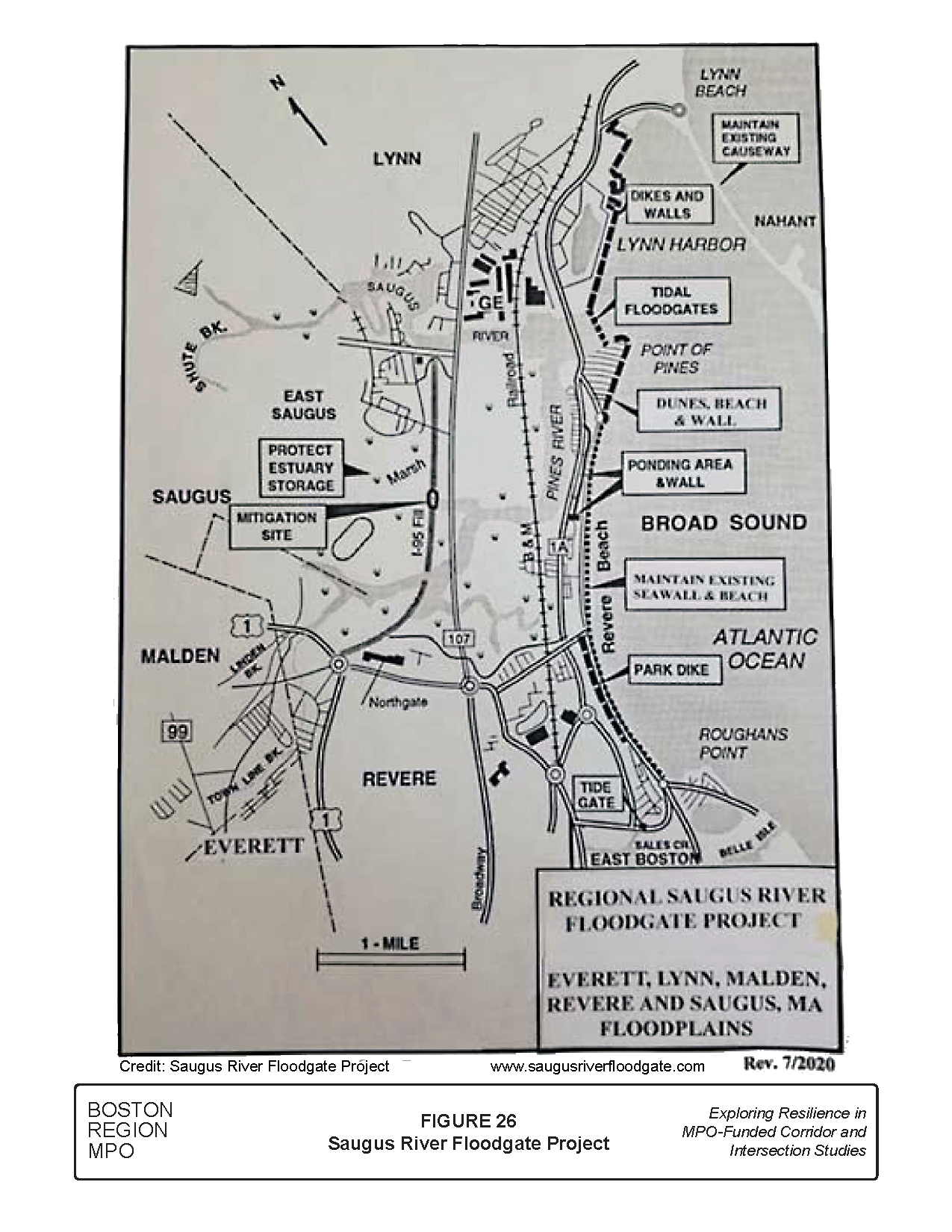
This project has a broader goal than the Route 1A study as the floodgate and shoreline improvements would protect housing, businesses, transportation infrastructure, and environmental resources. Therefore, MPO staff suggests coordination of resilient measures for Route 1A, bridge repairs, and the reconstruction plan for the General Edwards Drawbridge, and the Regional Saugus River Floodgate Project to ensure integrations and co-benefits.
The total cost would be $231 million (in 2020 dollars), including purchasing the 1,650-acre estuary for flood water storage and the added cost of restoration of Rumney Marsh.
Route 1A is highly exposed to sea level rise, storm surge, and extreme precipitation—all threats that are projected to increase significantly in the future. Recent inspections as part of the Environmental Protection Agency’s (EPA) efforts to restore the saltwater marsh in the Rumney Marsh Reservation indicated some of the culverts and tidegates are malfunctioning, crushed, or obstructed with debris.
A drainage assessment of the hydraulic and hydrologic capacities of the culverts and tidegates is required. The assessment will determine the necessary short-term repairs and the size of larger replacement culverts in the medium-term to help increase tidal water exchange to saltwater marshes as well as protect Route 1A from floods and washouts. In addition, we recommend that MassDOT maintain regular inspections of the seven self-regulating tidegates to keep them functioning and maintained to ensure flushing of the saltwater marshes.
Many of the culverts under the Route 1A corridor are almost 50 years old (installed in 1972) and may be inadequate to handle storm surges and heavy rains. Undersized culverts can be overwhelmed leading to overtopping and damage to the roadway and surrounding ecosystem, blocking access to habitat for aquatic organisms, and flooding properties and facilities.
Assessing and resizing culverts based on projected climate data is recommended for all culverts under Route 1A in the study limits.
The installation of larger culverts may result in flooding at downstream locations with undersized culverts as larger volumes of water flow through the upstream culverts. While this impact is not anticipated in the Route 1A corridor, downstream flooding is usually addressed through evaluation of the drainage basin.
The cost of replacing culverts varies and depends on materials, size, and additional components, such as self-regulating tidegates. The cost of replacing a culvert on a principal arterial is generally considered high, costing between $50,000 and $100,000. The implementation timeframe is usually between two and five years.
The capacity to collect, convey, and discharge stormwater flows to large bodies of water would be reduced by higher water levels as sea level rises. Drainage outfalls that are below projected water levels for high tides or storm surge should be elevated. These outfall pipes could be fitted with check valves to prevent backups and be pumped rather than gravity drained. There are four pump stations located in the low-lying areas near the Route 1A corridor and many in other parts of Revere. The pump stations are owned and maintained by the City of Revere.
Stormwater pumps help to protect areas by pumping away large volumes of water, thereby preventing the occurrence of flooding. With the expected rise in sea level, frequent storm surges, and extreme precipitation, reliability of stormwater pump stations is the key to ensuring that people, homes, roads, bridges, culverts, commercial buildings, and many other facilities are protected when faced with flooding. Reduced discharge capacity and/or failures of pump stations could cause flooding leading to potentially significant consequences.
Detailed assessments of stormwater pump stations, considering projected climate data, are required for the corridor’s long-term flood protection strategy. Such analysis would help to determine the existing conditions, capacity, and overall functionality of the pump stations, and necessary upgrades to increase pumping capacity, provide emergency power, relocate drainage outfalls, and add new stormwater pump stations to vulnerable areas. Upgrading stormwater pump stations would help prevent areas from flooding and related damage in the future and allow those areas to recover faster from flooding. Additional investment would be necessary for off-site monitoring and control of these facilities.
Existing stormwater pump stations in the corridor, especially in the northern segment of Route 1A would need assessments. Also, new stormwater pump stations for locations projected to be flooded in the future, especially, in the southern segment of Route 1A, as indicated in the flood risk probabilities maps would need assessment. Figure 27 shows example pump stations.
Stormwater pumps can protect neighborhoods and assets and allow flood waters to drain more quickly from an area. They are good near-term, medium-term, and long-term investments for both the northern and southern segments of Route 1A.
The cost of upgrading stormwater pump stations varies greatly and depends on several system components. Upgrading stormwater pump stations is a high-cost, medium-term project with a five-year to 10-year implementation timeframe.
Best practices for stormwater management are designed to reroute stormwater runoff from roadways and other impervious surfaces, minimize the discharge of polluted runoff into local waterways, and control flooding. Pollutants can be removed through vegetative filtering, sedimentation, biological uptake, infiltration into the underlying soil, and nutrient uptake by plants and other aquatic organisms.
Stormwater controls include detention and retention basins, constructed wetlands, biofilters (wet swales and sand filters), and bioretention. (See Figure 28.) These stormwater controls are classified into wet and dry pools. Wet pools are appropriate for larger catchments and have a permanent pool of water, which is replaced with stormwater during storm runoff events. Dry pools systems hold stormwater for short periods of time, especially during intense storms, to reduce peak storm runoff, collect sediment from the flood water, and decrease flood damage. Some stormwater controls, such as detention basin systems, employ medium-sized pump stations to increase efficiency and further reduce the frequency of flooding.
Detention and retention basins are more appropriate for the low-lying areas along the southern segment of Route 1A, though this area is expected to experience far less flooding compared to the northern segment.
Figure 27
Example Pump Stations
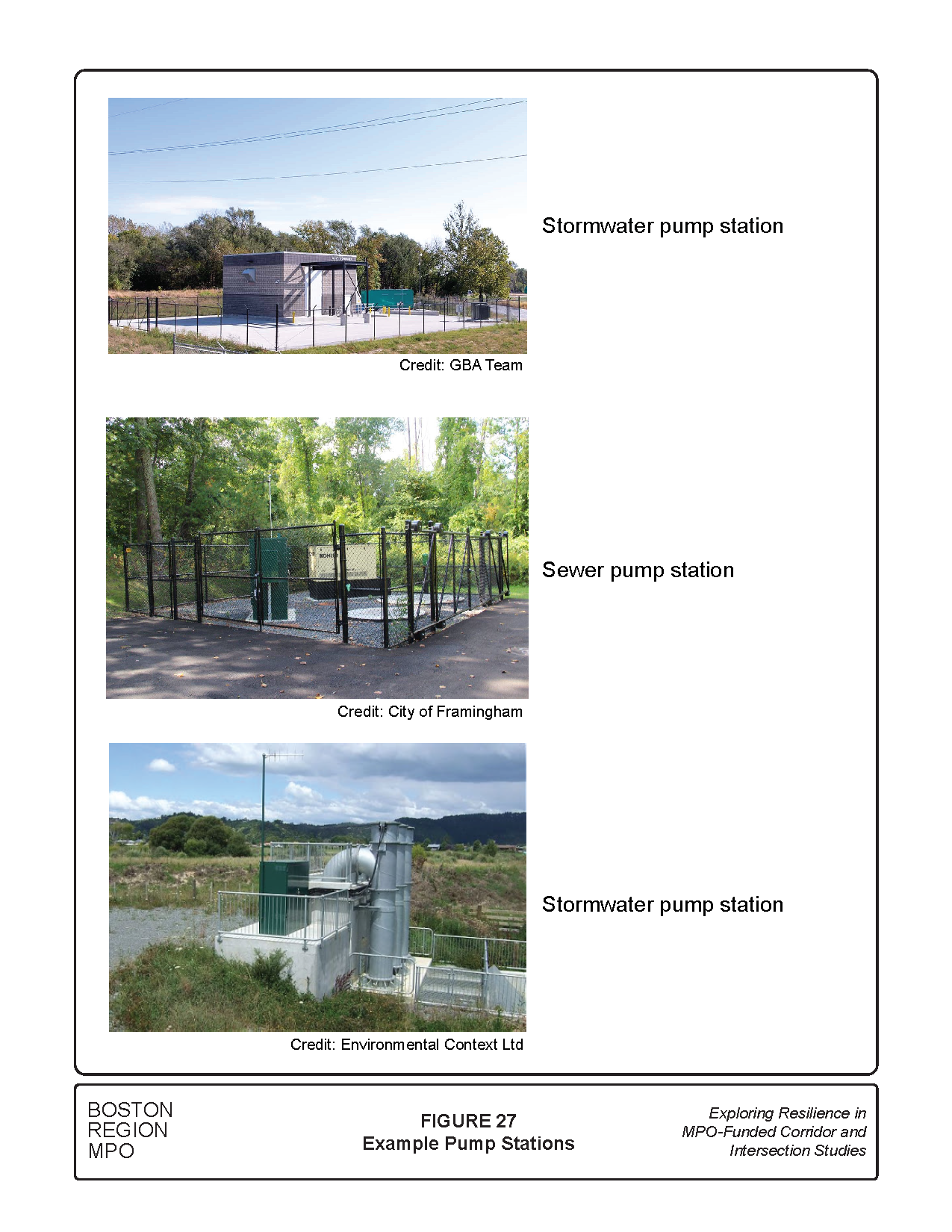
Figure 28
Stormwater Management Practices
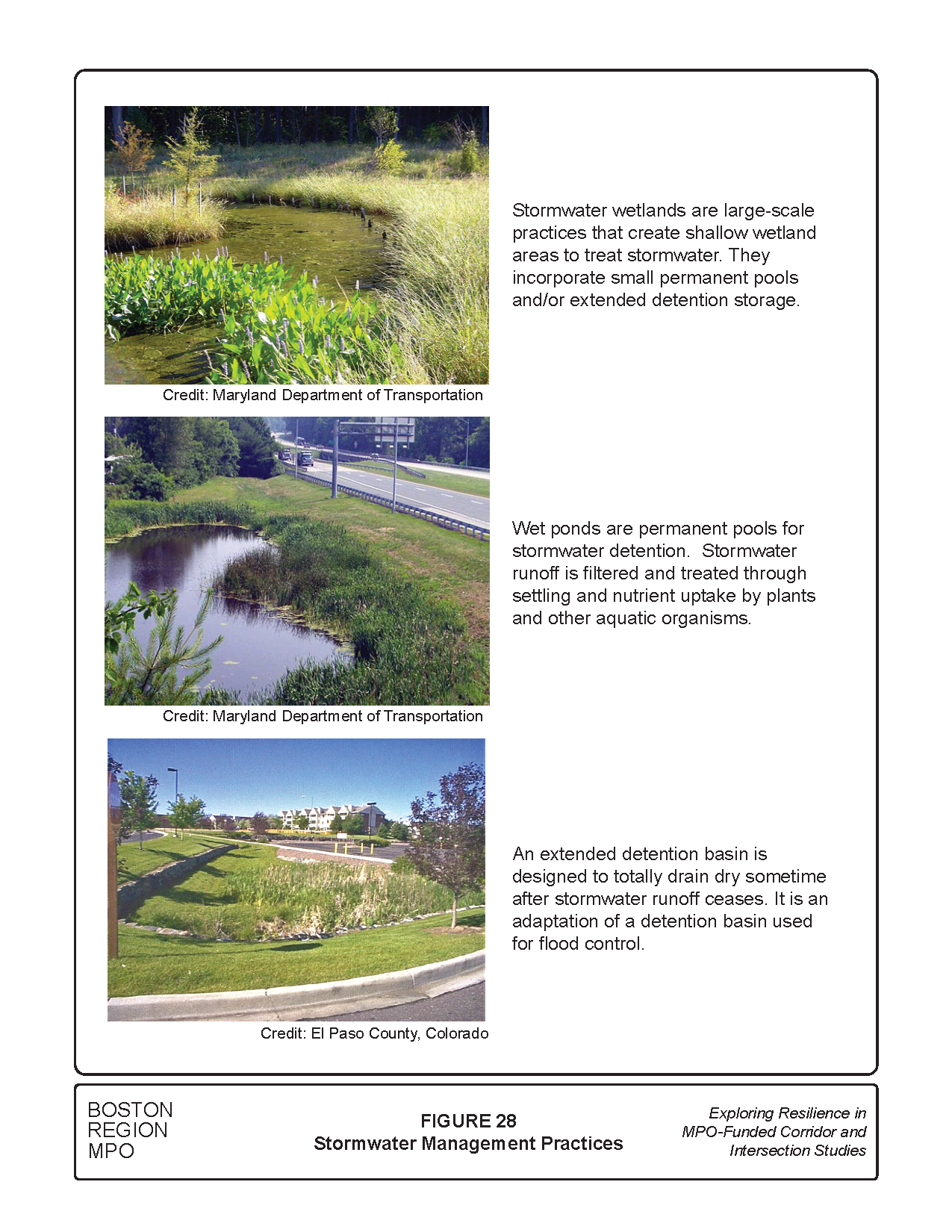
The cost of stormwater controls varies by type and size. The cost of highway detention basin systems ranges from $100,000 to $200,000.
Based on the flood risk probability and depth maps, Route 1A is already at risk of flooding. Elevating the roadway is one option to consider for ensuring that Route 1A can continue to provide access to vital services and facilities in the future. Figure 29 shows an example of a road raised in response to climate change impacts.
The decision to protect Route 1A requires an assessment of the roadway’s elevation profile and many variables, including sea level rise estimates, protection afforded by existing and projected marshes and rock revetments, present and future transportation needs, and costs for stormwater control infrastructure and measures.
Elevating transportation assets in the area is not limited to Route 1A. The MBTA’s Newburyport/Rockport commuter rail line and Route 107, which run through the Rumney Marsh Reservation, are in the same situation.
The northern segment of Route 1A (Revere Street to Mills Avenue) is the critical segment that could be raised. The area is projected to experience frequent inundations beginning in 2030 and worsening over time. There are limited properties abutting the roadway in this segment, which minimizes the impact a higher roadway elevation would have on neighborhoods by creating drainage problems or potentially funneling damaging water into homes. However, some residents of Riverside and Point of Pines abutting Route 1A would be affected by this option.
This option would impact residents of Riverside and Point of Pines as a raised road would cause flooding, water pooling, and driveways would be at such a steep slope that they would be inaccessible. Specifically designed to adapt to sea level rise, raised road designs typically include features for collecting, pumping, and treating stormwater that runs off the raised roads. Hence, to prevent raised roads from channelizing stormwater to homes and properties at lower elevations, municipalities often use stormwater pumps, stormwater clearing drains to remove this excess water, and stormwater controls to store, treat, and discharge stormwater.
Figure 29
Examples of Roads Being Raised Because of Rising Sea Levels
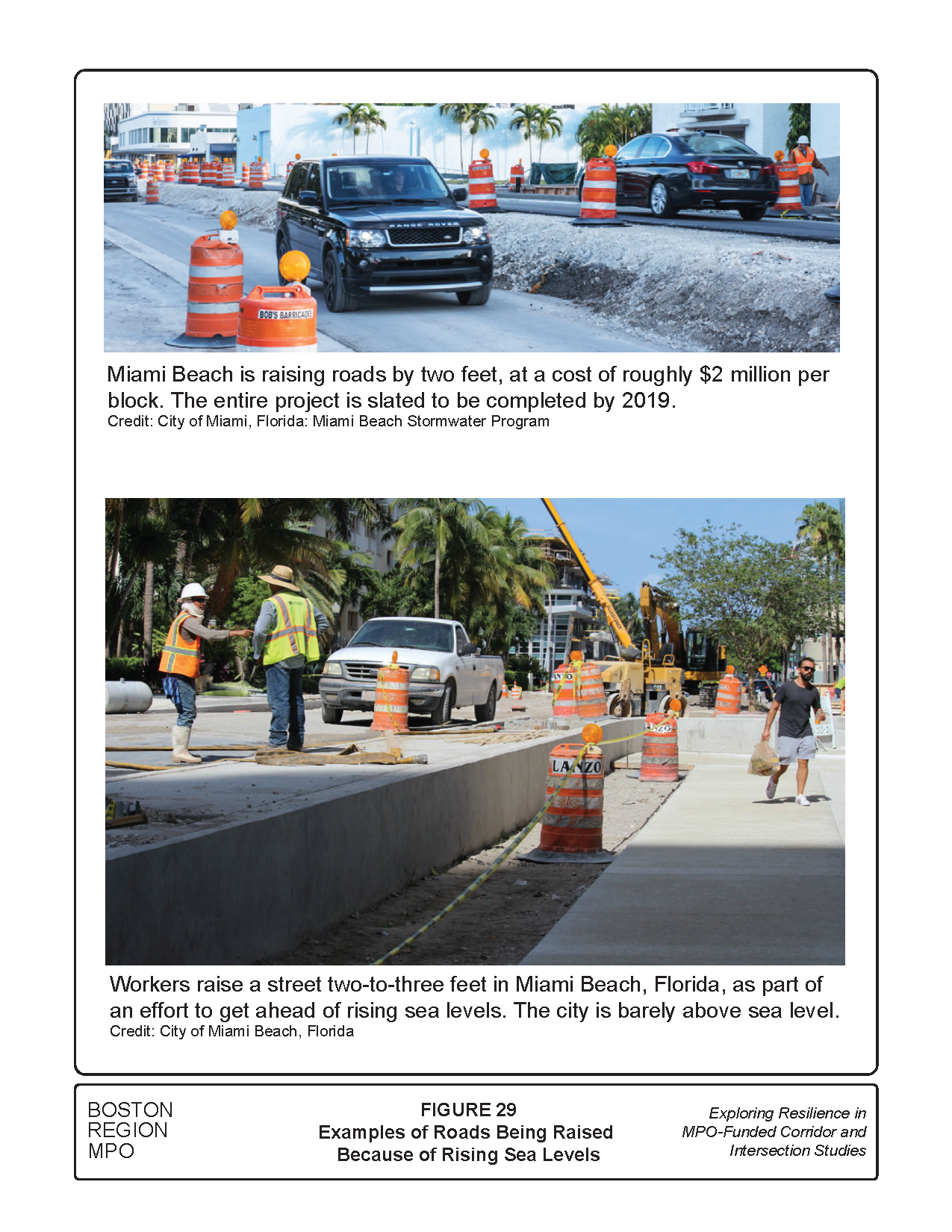
Elevating the roadway, bridges, structures, and utilities above the projected flood elevations would have economic benefits and avoid social and psychological impacts associated with a disruption to or loss of Route 1A, which could result in long commuting times and congestion on limited diversion routes. By incorporating nature-based solutions to complement the elevation project, ecological impacts from construction to the adjacent saltwater marsh, tidal flats, and sanctuaries for fishes and birds would be reduced.
Roadway reconstruction projects are usually high-cost and long-term projects. The implementation timeframe is usually 10 or more years.
The adaptation options described above can be combined in several ways to maximize benefits (hybrid solutions) or add on resilience measures over time to reduce costs due the uncertainties in future projections (adaptive and modular solutions).
Nature‐based features possess some inherent capacity to reduce storm hazards through reductions in wave height, flood depths and extent, and erosion. These natural systems are most effective at mitigating these hazards under low to moderate intensity events. Revetments and bulkheads are commonly used along with nature-based solutions to protect infrastructure, including coastal roads and bridges threatened by high energy waves.
For storms with high energy waves threatening a coastal highway, combining nature‐based approaches with structural (gray infrastructure) may address some of the shortcomings, while simultaneously enhancing the resilience of both the infrastructure and the ecosystem.
Hybrid solutions are appropriate for the northern segment of Route 1A because of its proximity to the Rumney Marsh Reservation. This segment would be inundated the most, according to the flood probability and depth maps, and would likely require some structural solutions (revetments, bulkheads, and the raising of the roadway) to complement the recommended nature-based solutions.
While there may be benefits and opportunities for hybrid solutions, it is important to acknowledge the long‐term impact of these options as well. Experts in nature-based and coastal structural solutions must be involved to identify options that work together for co-benefits and to avoid damage to the existing ecosystem.
Nature-based solutions are generally low-cost, while structural solutions are high-cost. By extension, hybrid solutions are high-cost, depending on the options included in the solution, but generally they offer long-term benefits. Table 8 presents relative costs of shoreline stabilization options.
Table 8
Relative Costs of Shoreline Stabilization Options
Technique |
Design and Permitting Costs |
Construction Costs |
Expected Maintenance Frequency1 |
Average Annual Maintenance Costs2 |
Average Annual Mitigation Costs3 |
Artificial dunes and dune nourishment |
Low |
Low |
1–5 years |
Low |
None |
Controlling overland runoff |
Low |
Low |
5–20 years |
Low |
None |
Planting vegetation |
Low |
Low |
1–3 years |
Low |
None |
Bioengineering—coir rolls on coastal banks |
Low-Medium |
Medium-High |
1–3 years |
Low-Medium |
Low |
Bioengineering—natural fiber blankets on coastal banks |
Low |
Low |
1–3 years |
Low |
None |
Sand fencing |
Low |
Low |
3–5 years |
Low |
None |
Beach nourishment |
Medium |
Low-Medium |
5–10 years |
Low |
Low |
Rock revetments—toe protection |
High |
High |
10–20 years |
Low |
Low- Medium |
Rock revetments—full height (up to predicted flood zone elevation) |
Very High |
Very High |
20–25 years |
Low |
Medium |
Seawall |
High-Very High |
Very High |
25–40 years |
Low |
Medium-High |
Note: Construction cost estimates (average cost per linear foot of shoreline): Low: less than $200; Medium: $200-500; High: $500-1,000; Very High: >$1,000.
1The frequency of required maintenance is highly dependent on storm severity and frequency and shoreline exposure. See StormSmart Properties fact sheets for details on maximizing longevity.
2Estimated annual costs averaged over the life of the project to maintain project components, assuming the project is designed and installed properly
3Estimated annual costs averaged over the life of the project to compensate for the technique’s adverse effects
Source: Massachusetts Office of Coastal Zone Management.
Adaptive and modular solutions involve a collection of policies, nature-based measures, and structural measures to reduce flood risk. The purpose of these solutions is to enable a transition from one measure to another over time to account for uncertainty in future projections. These solutions provide flexibility among policies and measures, thereby spreading costs over time. For example, instead of designing for a 2070/2100 planning horizon, an adaptive/modular approach could use a 2050 planning horizon and integrate flexibility to add-on future improvements depending on monitoring results.
Climate models provide valuable insights about how the climate would respond to rising concentrations of greenhouse gases. However, climate model projections are subject to uncertainty and are still evolving. Hence, it could be prohibitively expensive to prepare for all possible outcomes. Instead, adaptive management approaches are designed for flexibility and facilitating climate resilience throughout the life of infrastructure assets.
Adaptive and modular solutions are recommended for the northern segment of Route 1A because of the high cost of structural solutions that would be required to protect the assets. A typical approach is a hybrid solution that starts with nature-based solutions and then, based on monitoring results, adds the options of rock revetments and larger culverts, and then pump stations, and ultimately raising the road if necessary.
Monitoring is key to the adaptive and modular approach. It informs the decision-making process as to when and where to add on the next measure to enhance resilience. The approach could lead to substantial cost savings and prevent adverse environmental impacts on ecosystems and habitats.
Depending on monitoring results, adaptive and modular solutions can be low cost if only nature-based solutions are needed, or high cost if structural solutions are needed in the future.
Opportunities exist to make Route 1A resilient in a way that benefits the surrounding ecosystem. The City of Revere had already started restoring saltwater marshes to protect the ecosystem habitat and control flooding. Hence, the location of the roadway also provides opportunities to consider effective low-cost coastal highway resilience measures that incorporate nature-based solutions to complement marsh restorations.
There is no reliable alternative to Route 1A if it is flooded. The parallel and closest road, Route 107, also suffers the same issues as Route 1A—both roads are highly exposed to sea level rise, storm surge, and extreme precipitation. The MBTA’s Newburyport/Rockport commuter rail is also in the same situation. Hence, building resilience into Route 1A should be considered in the larger context along with the futures of Route 107 and the MBTA commuter rail line. The Regional Saugus River Floodgate Project is an example and presents opportunities for a regional collaboration as well as an interagency and multidiciplinary team to coordinate efforts, optimize capital investments, and protect vulnerable populations and assets.
Making Route 1A more resilient also presents the opportunity for flexible adaptive solutions to address near-term problems and for adding on future improvements as necessary based on monitoring results. Additional opportunities include new value creation in the surroundings to address environmental and social and equity impacts.
The next steps in this pilot study are for the MPO staff to work with the City of Revere, MassDOT, MBTA, EPA, CZM, DCR, and other stakeholders to build an interagency collaboration to advance the Route 1A resiliency project. This collaboration will facilitate addressing environmental issues and regulations and optimize investment opportunities by evaluating impacts beyond transportation perspectives. This project also has regional impacts, therefore regional coordination with legislators to build support for the project will be essential.
The following are the findings from the study:
1 A tidegate is usually mounted to a culvert on the tidal side. In the event of a storm surge, the tidegate will close and latch automatically and will resume normal water control when the tide returns to normal cycles and levels. The intent of a self-regulating tidegate is to allow for tidal flushing of saltwater marshes during normal tidal cycle, while providing flood protection for upland areas.
2 Commonwealth of Massachusetts, "Executive Order No. 569: Establishing an Integrated Climate Change Strategy for the Commonwealth” (September 2016).
3 Commonwealth of Massachusetts. Massachusetts State Hazard Mitigation and Climate Adaptation Plan, (September 2018).
4 United States Code, Sec. 322. Mitigation Planning (42 U.S.C. 5165), Robert T. Stafford Disaster Relief and Emergency Assistance Act (1988).
5 United States Code, Sec. 322. Mitigation Planning (42 U.S.C. 5165), Robert T. Stafford Disaster Relief and Emergency Assistance Act (1988).
6 The Federal Disaster Mitigation Act of 2000 requires all municipalities that wish to be eligible to receive FEMA funding for hazard mitigation grants to adopt a local multi-hazard mitigation plan and update this plan in five-year intervals.
7 Code of Federal Regulations. Title 44- Emergency Management and Assistance, Part 201- Mitigation Planning (Washington, DC: October 2013), 364-374.
8 The MVP grant program provides support for cities and towns in Massachusetts to begin the process of planning for climate change resiliency and implementing priority projects. The state awards funding to communities to complete vulnerability assessments and develop action-oriented resiliency plans. Communities that complete the MVP program become certified as an MVP community and are eligible for MVP Action Grants and other opportunities.
9 Choate, et al., Synthesis of Approaches for Addressing Resilience in Project Development, Federal Highway Administration, United States Department of Transportation, (July 2017), 55.
10 Federal Highway Administration, Living Shoreline along Coastal Roadways Exposed to Sea Level Rise: Shore Road in Brookhaven, New York, (September 2016), 21.
11 City of Boston and Boston Planning & Development Agency, Coastal Flood Resilience Design Guidelines, (September 2019).
12 City of Boston and Boston Planning & Development Agency, Coastal Flood Resilience Design Guidelines, (September 2019).
13 Choate, et al., Synthesis of Approaches for Addressing Resilience in Project Development, Federal Highway Administration, United States Department of Transportation, (July 2017), 58.
14 Federal Highway Administration, “FHWA Order 5520: Transportation System Preparedness and Resilience to Climate Change and Extreme Weather Events," (December 2014), 1-6.
15 If the lowest rating for a bridge (superstructure, substructure, and deck) is at least seven, the bridge is classified as in good condition; a rating of five or six is fair; and a rating of four or less is poor.
16 These representative concentration pathways (RCPS) are potential trajectories of greenhouse gas concentrations set by the Intergovernmental Panel on Climate Change for climate modeling and research.
17 Coir rolls are organic living revetment that provide erosion control and rapid vegetation establishment. They support the growth and development of plants that physically secure the bank or shoreline.
18 Invasive Phragmites is a perennial, aggressive wetland grass that outcompetes native plants, marshes, and displaces native animals. Invasive Phragmites creates tall, dense stands which degrade wetlands and coastal areas by crowding out native plants and animals, exacerbating flooding, and can create fire hazards from dry plant material.